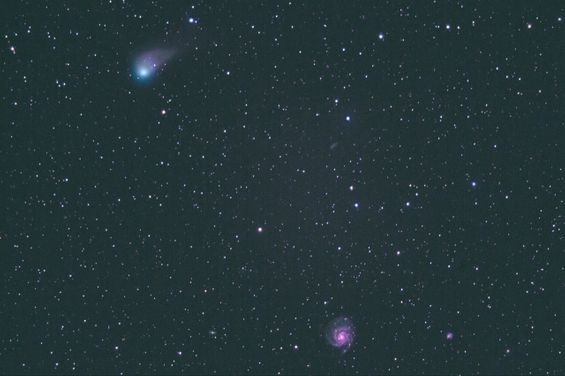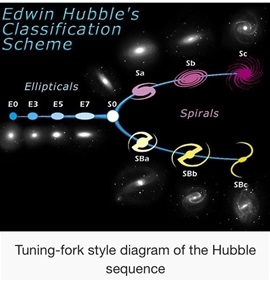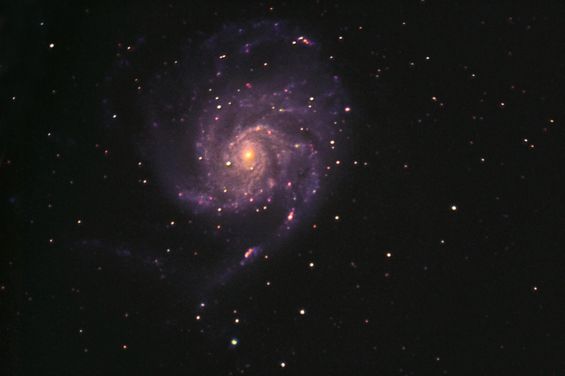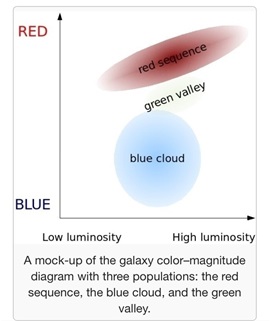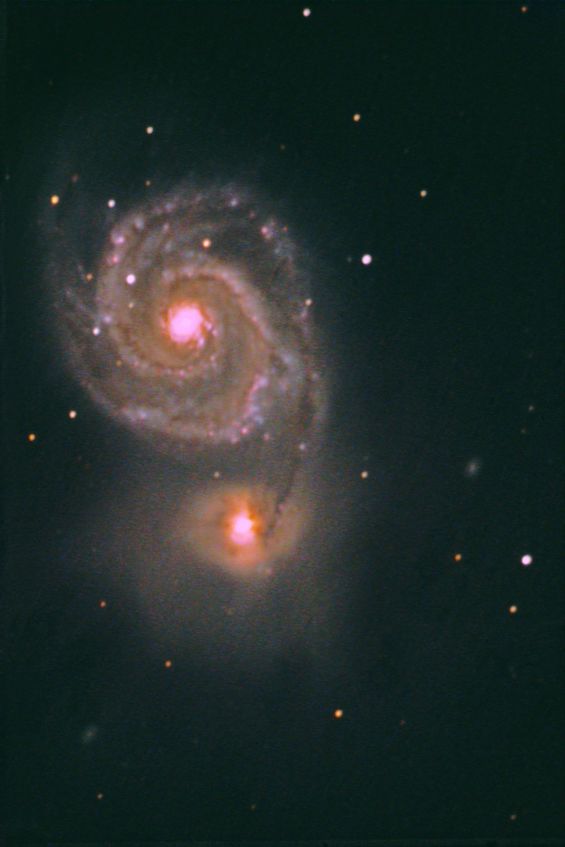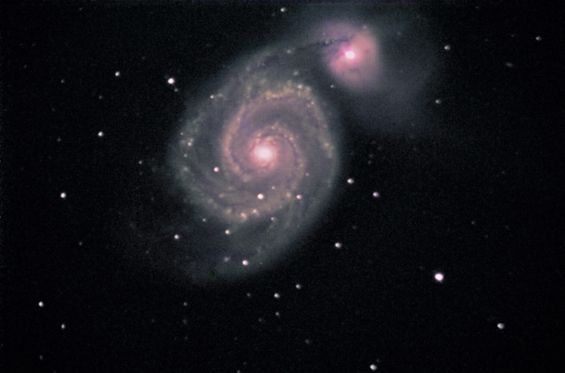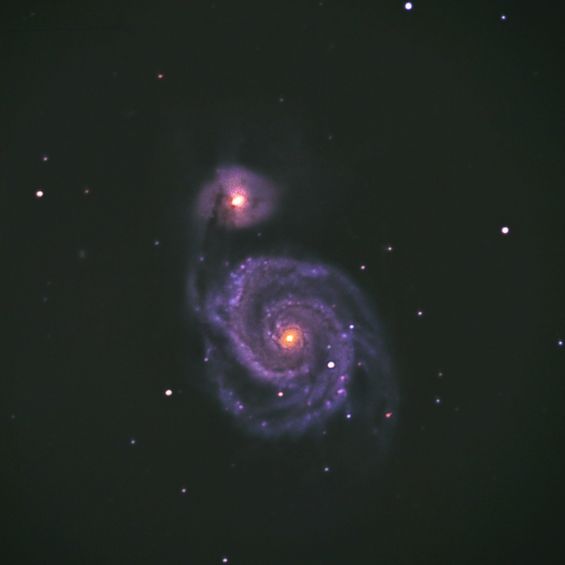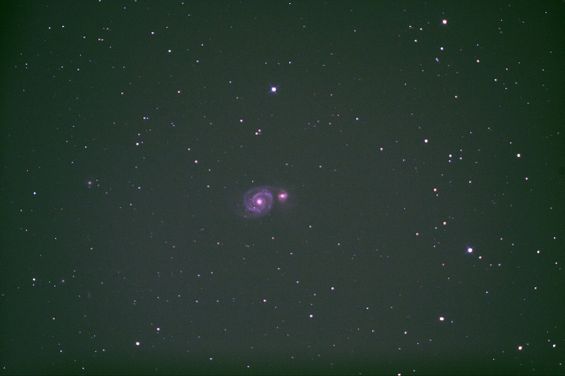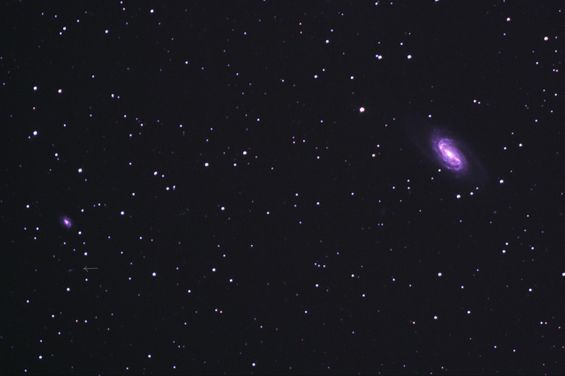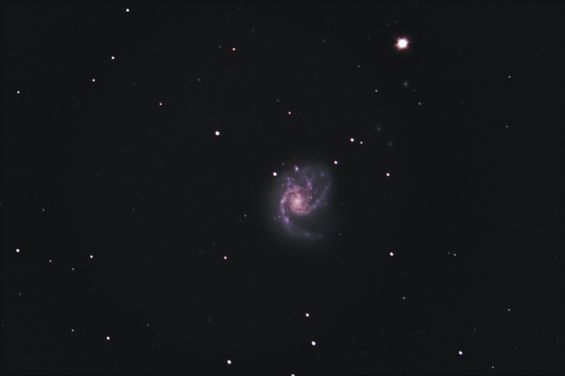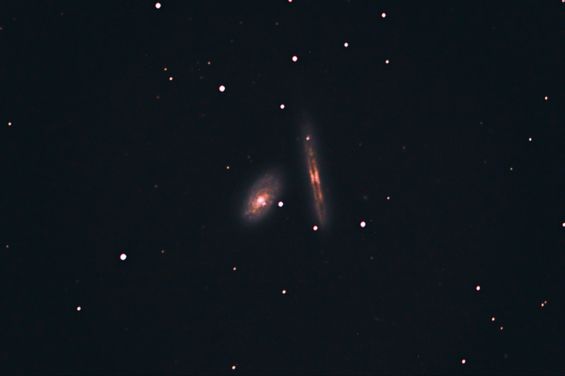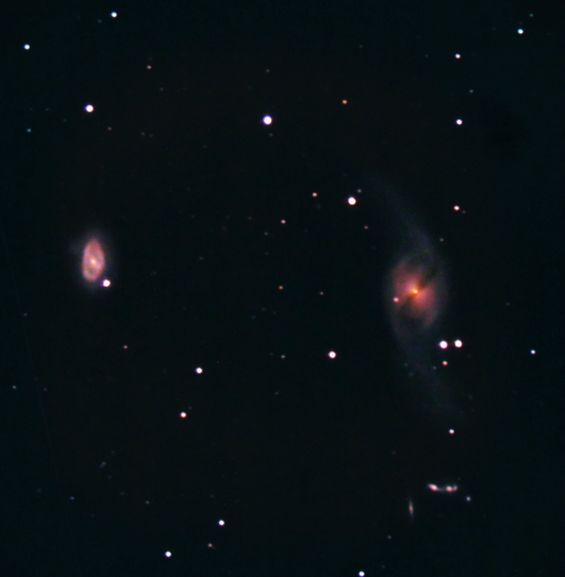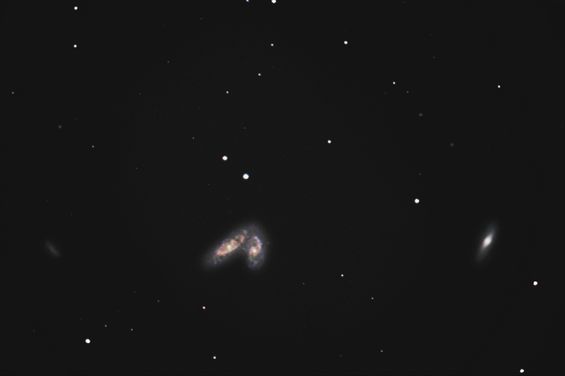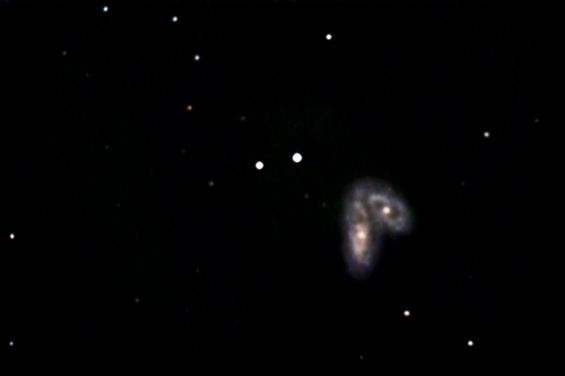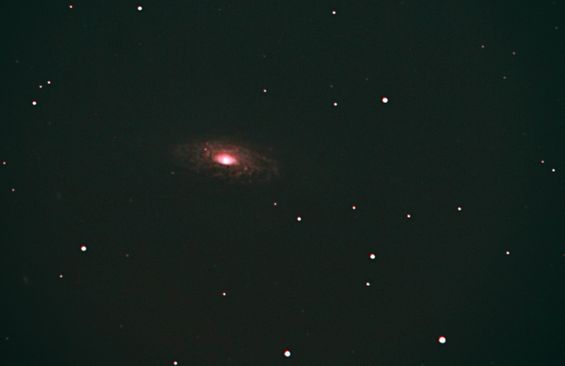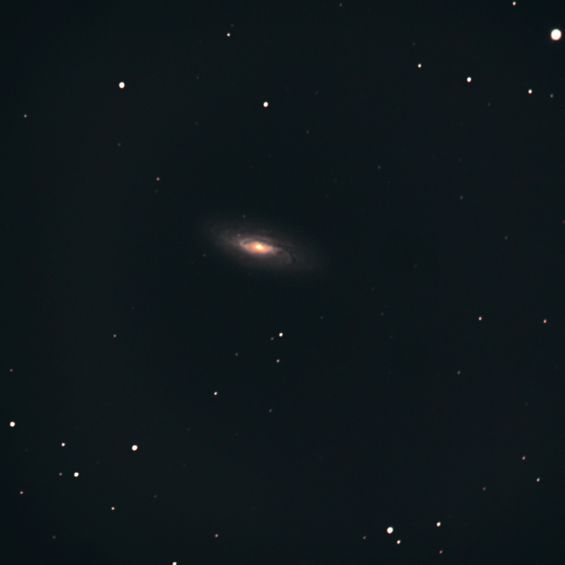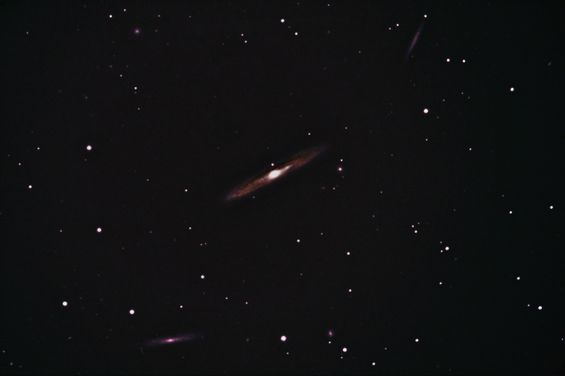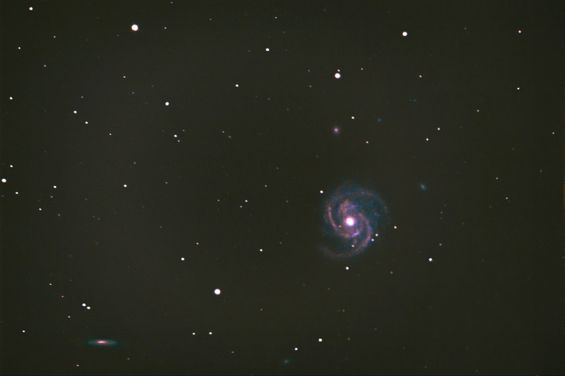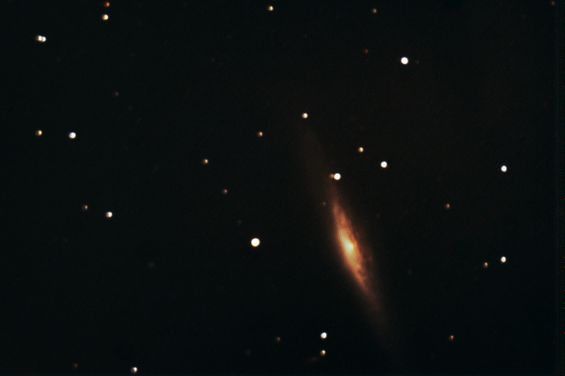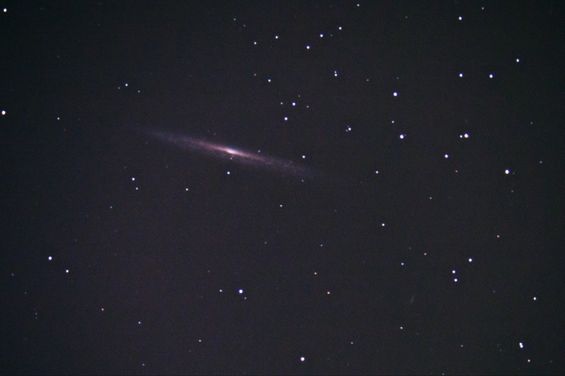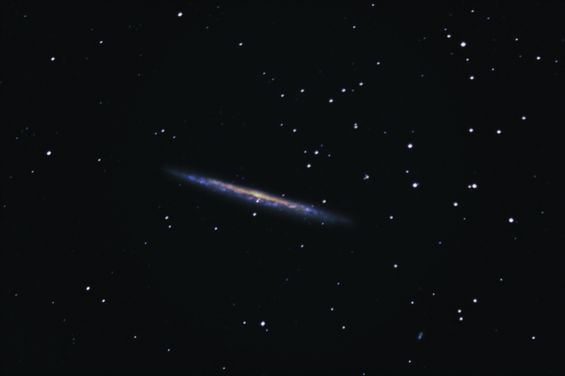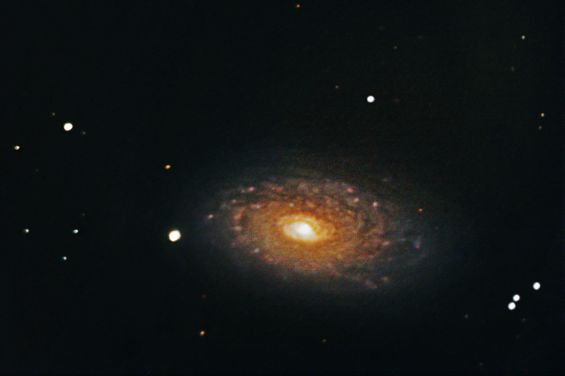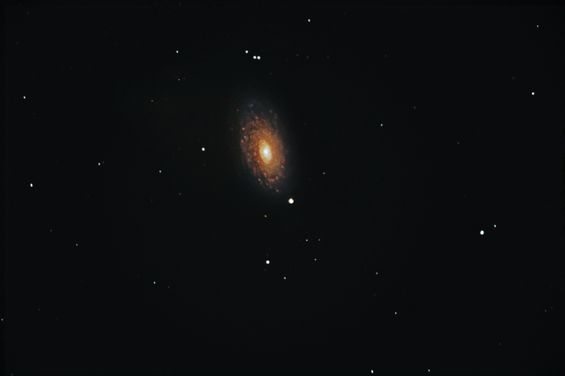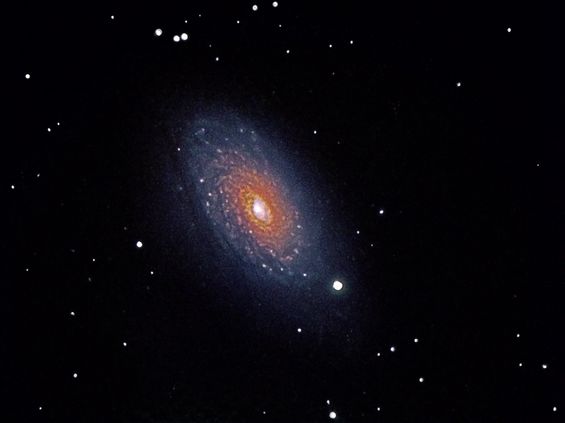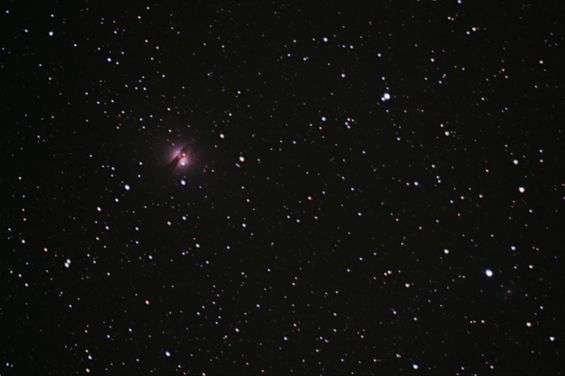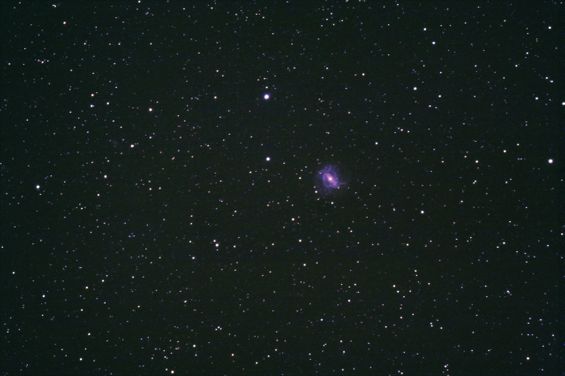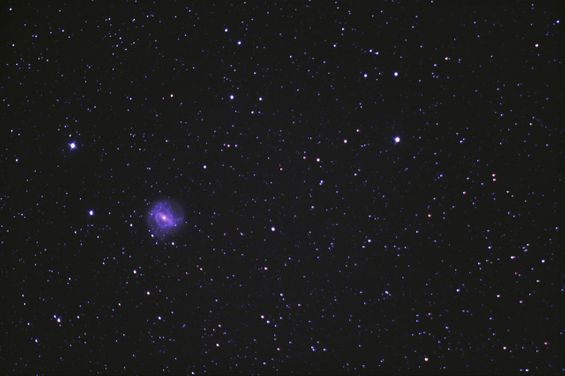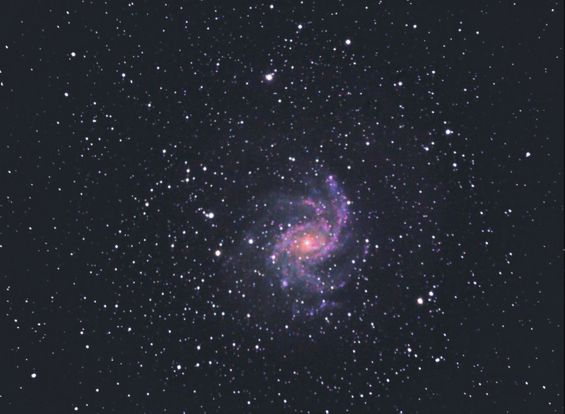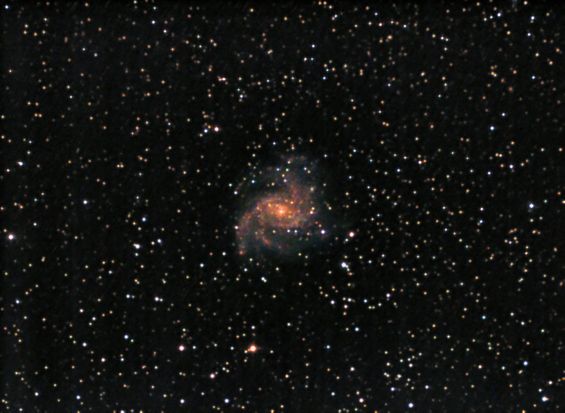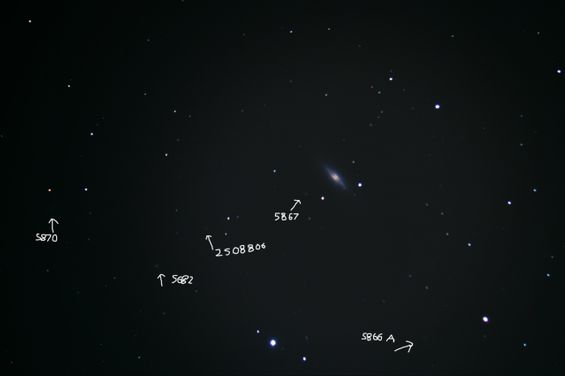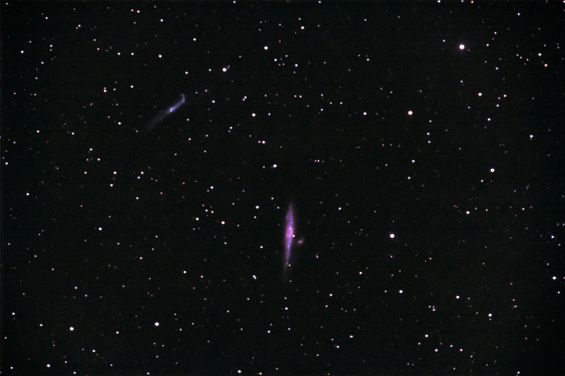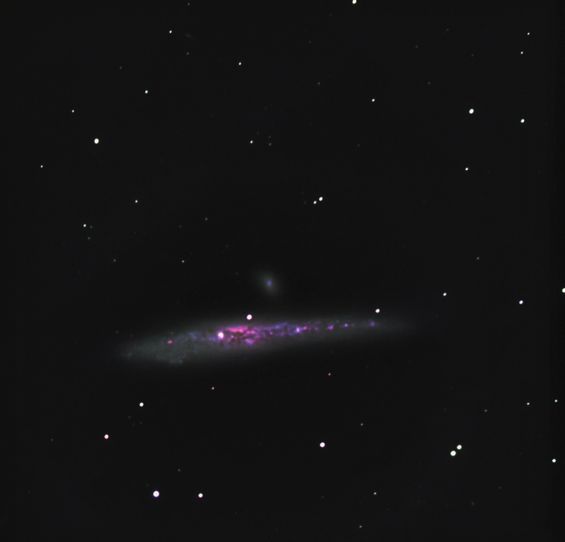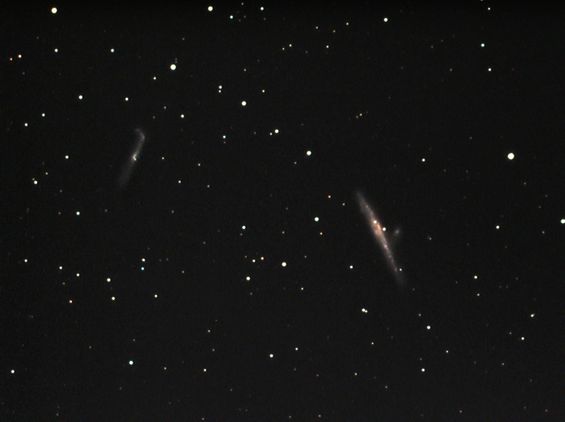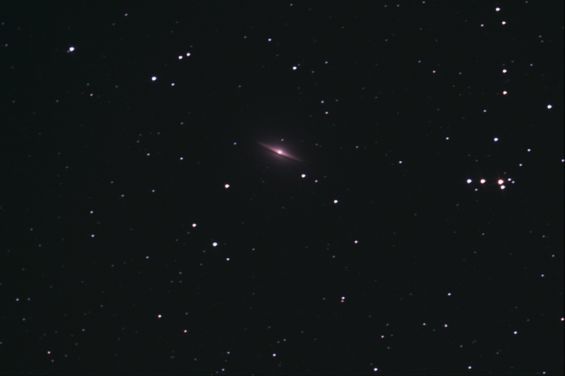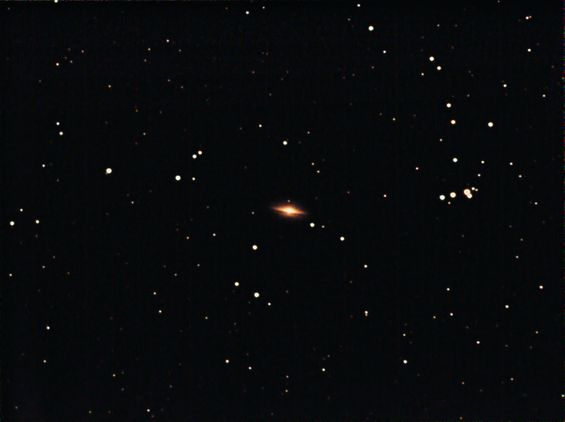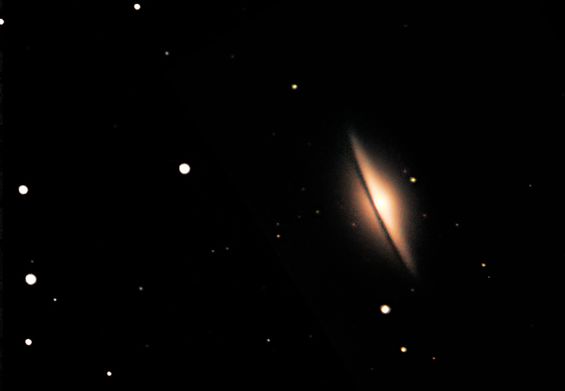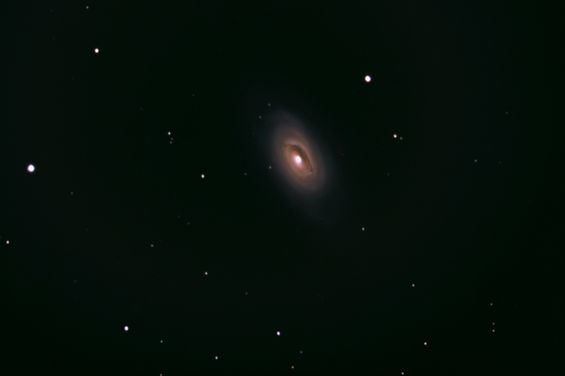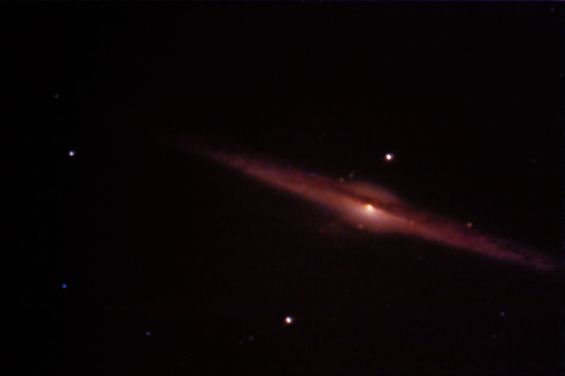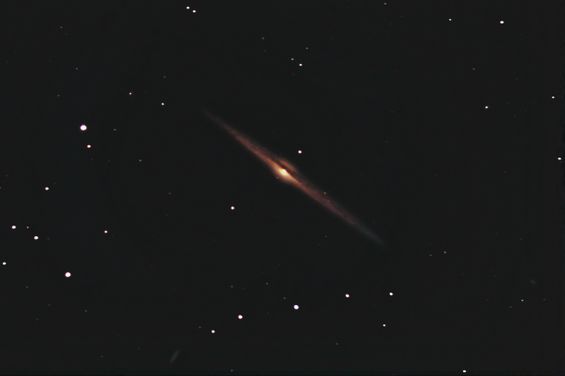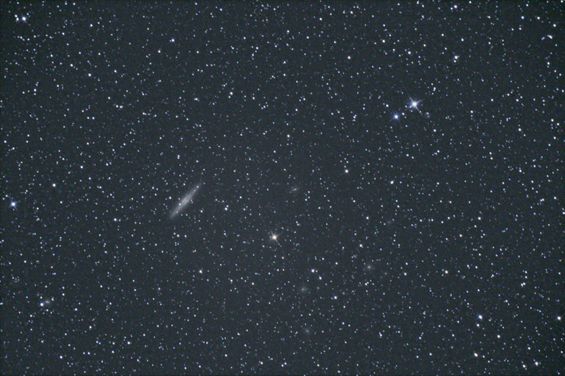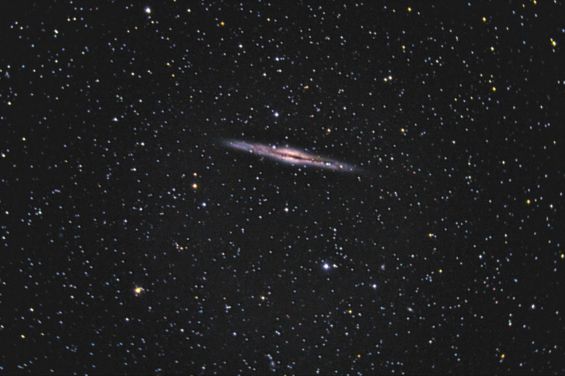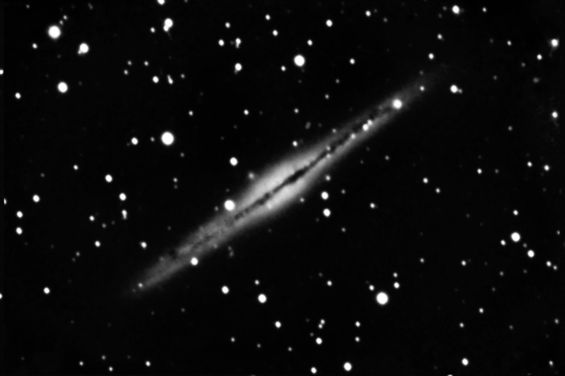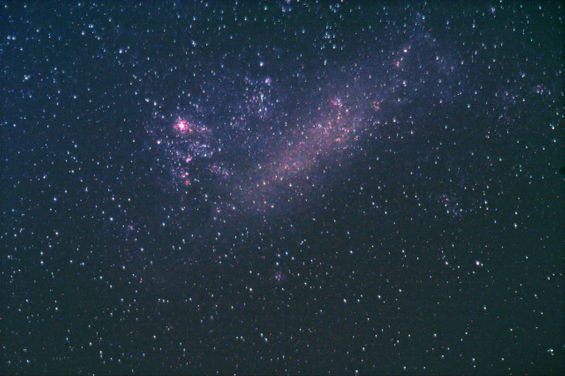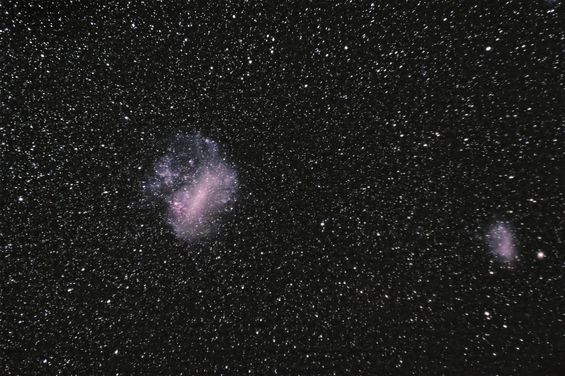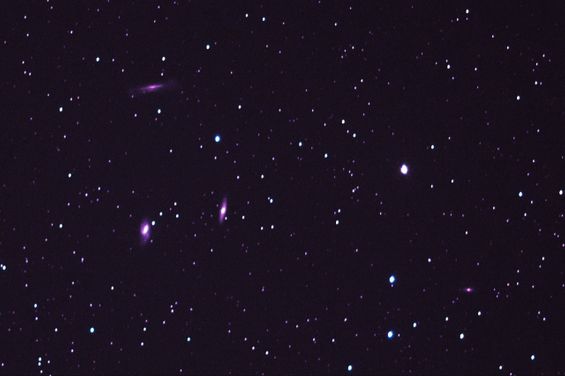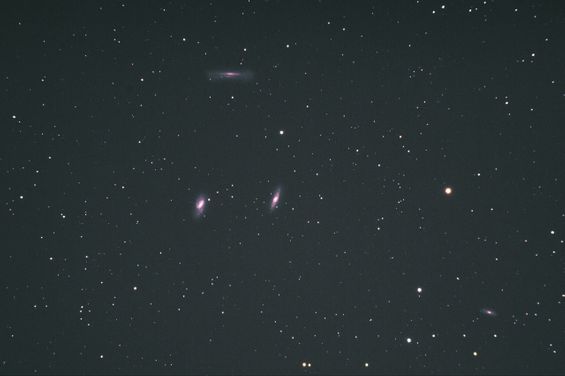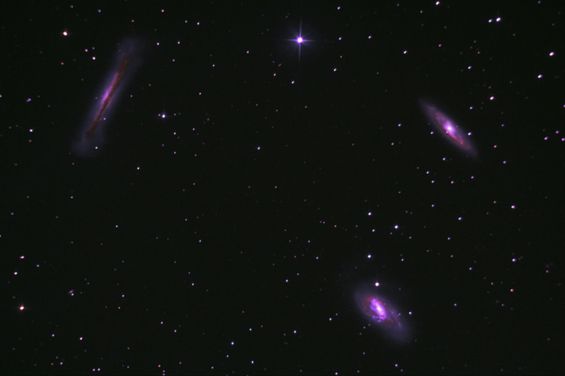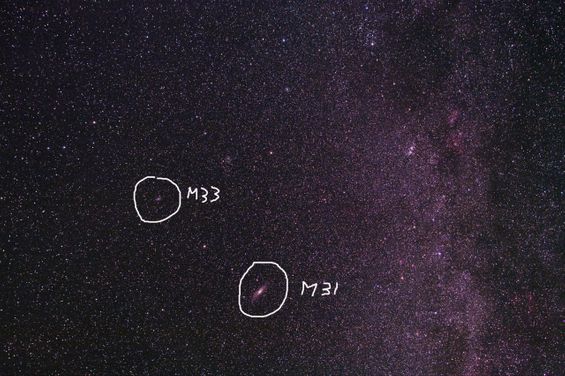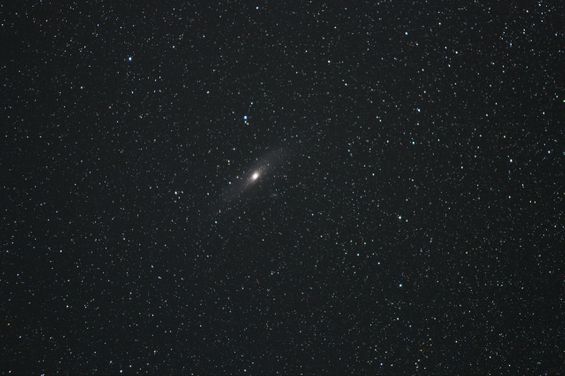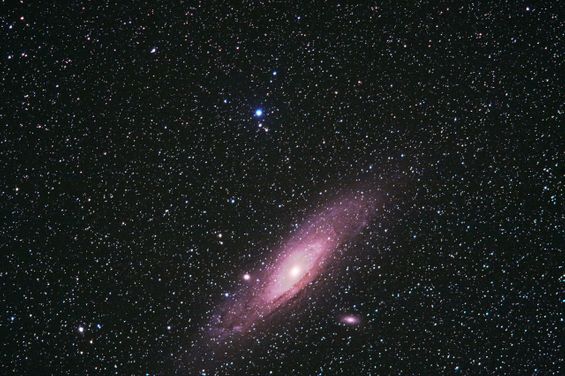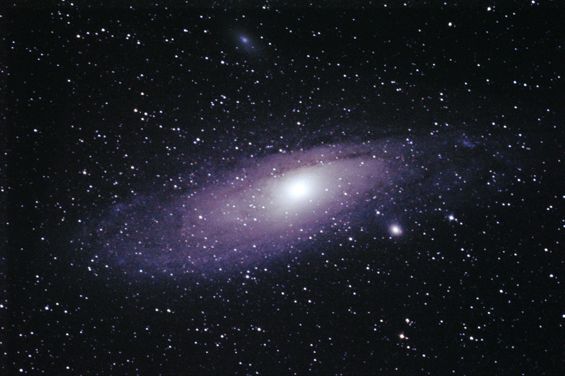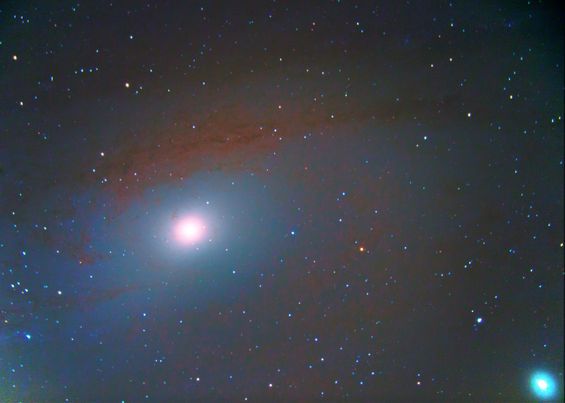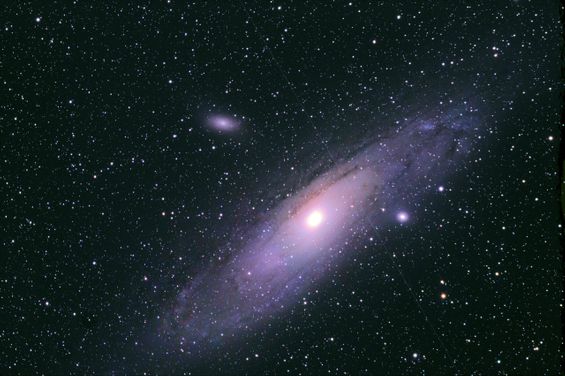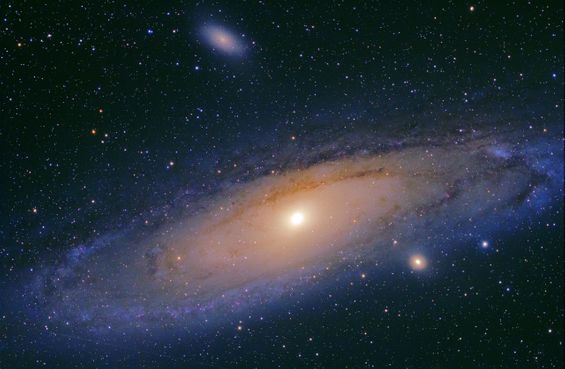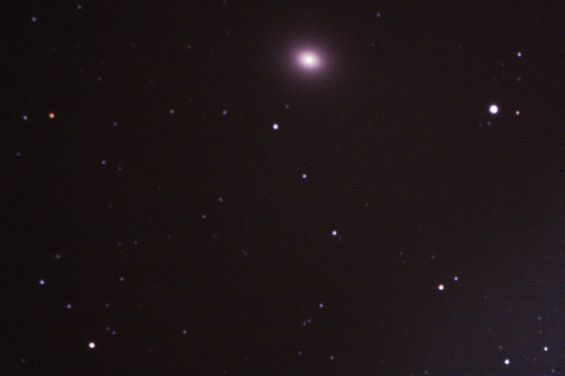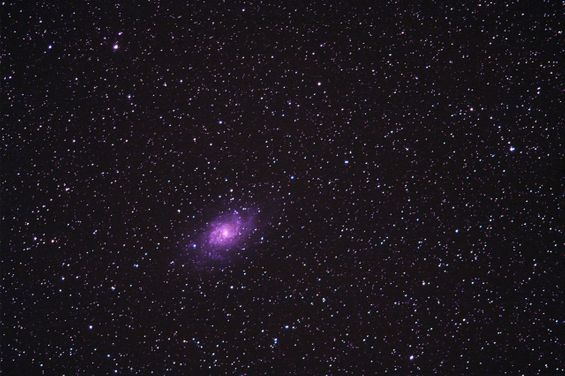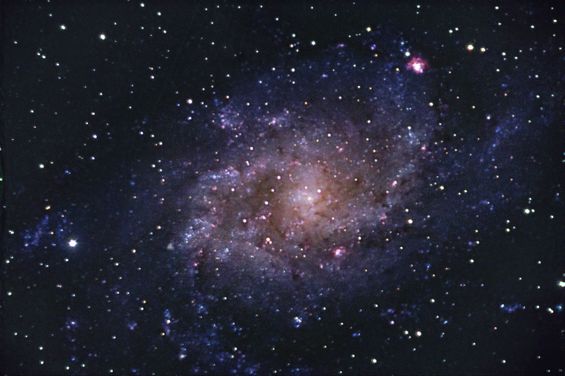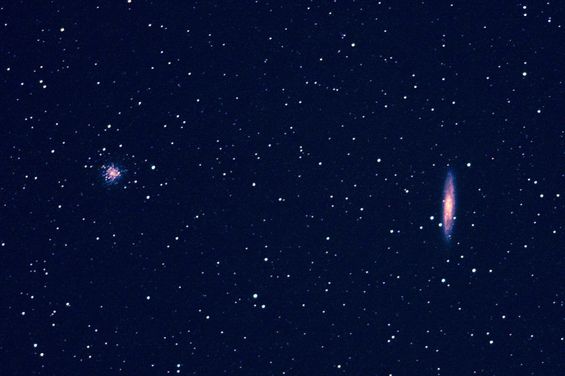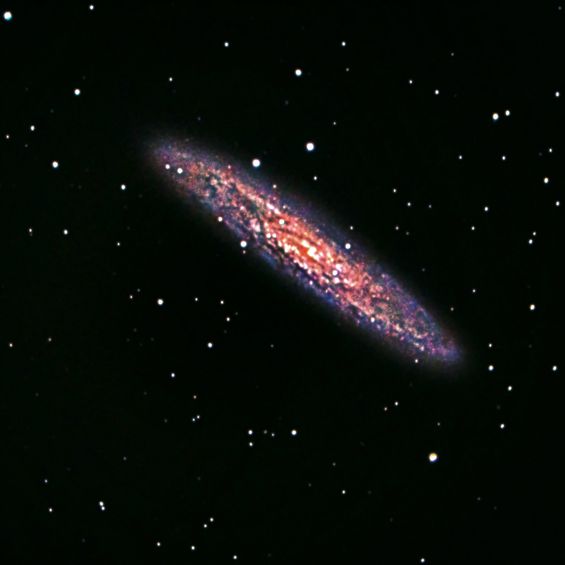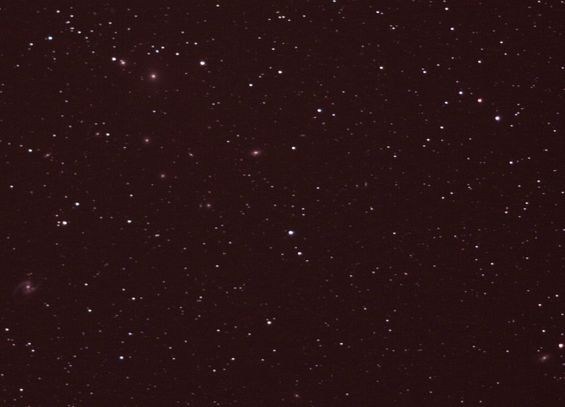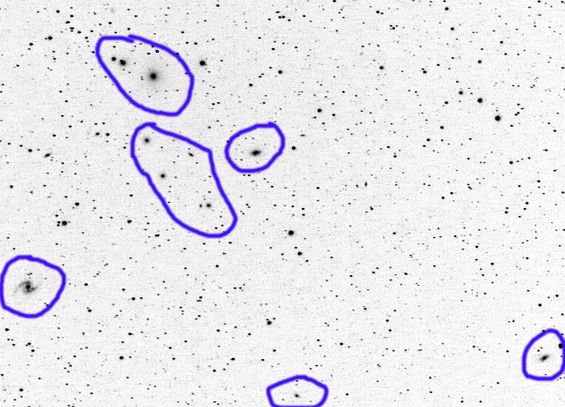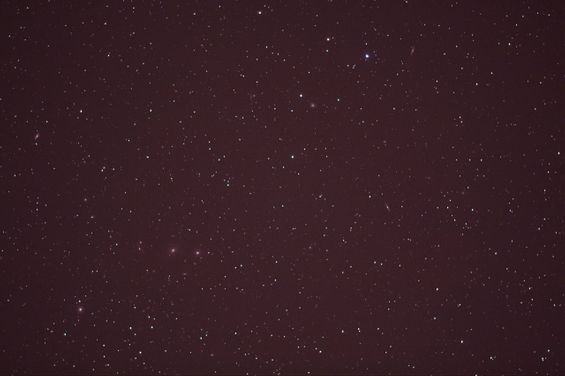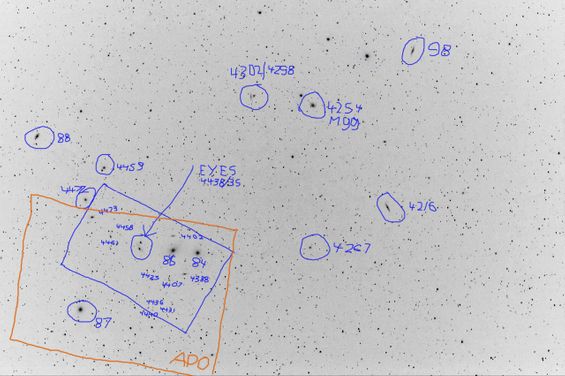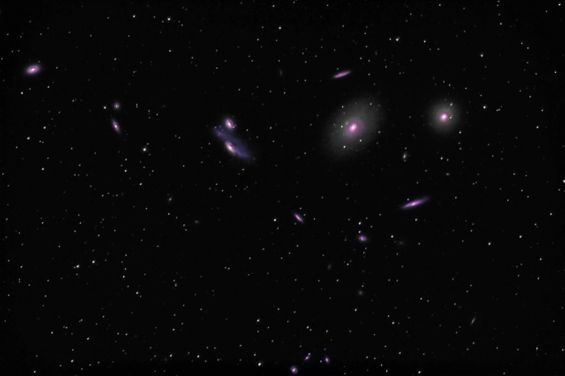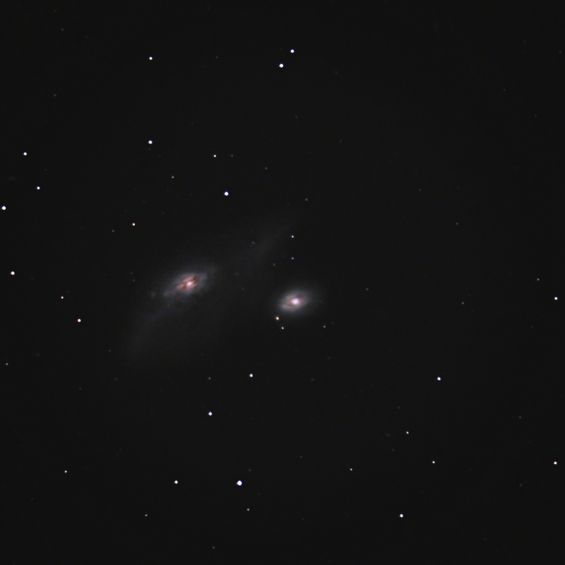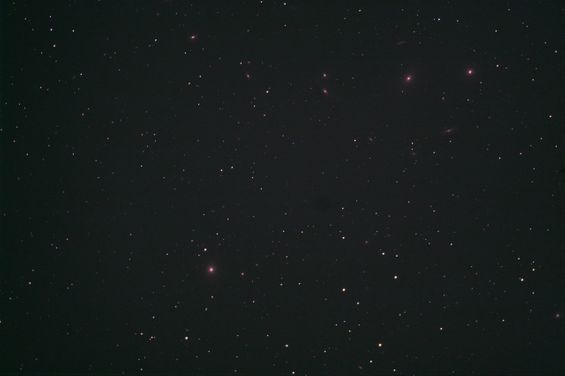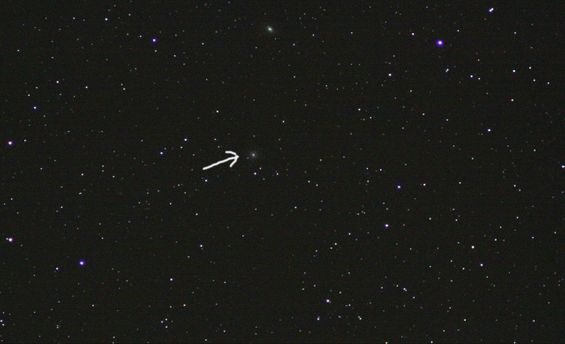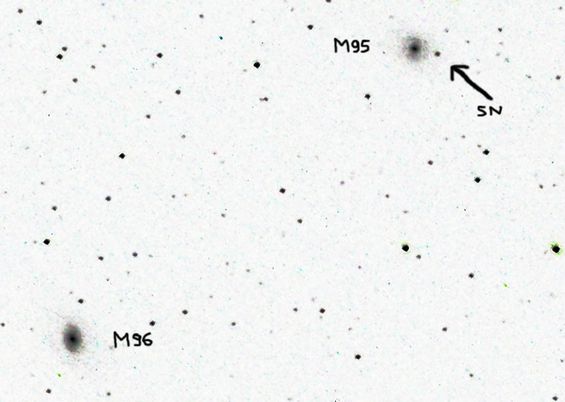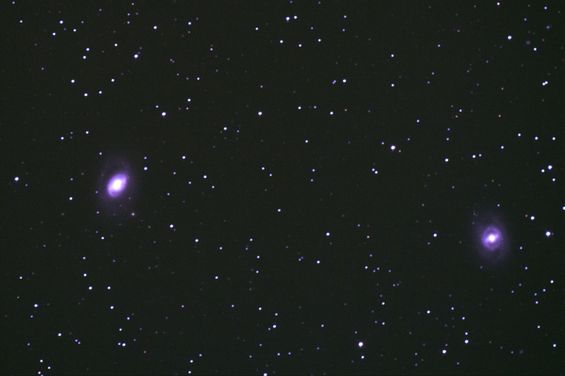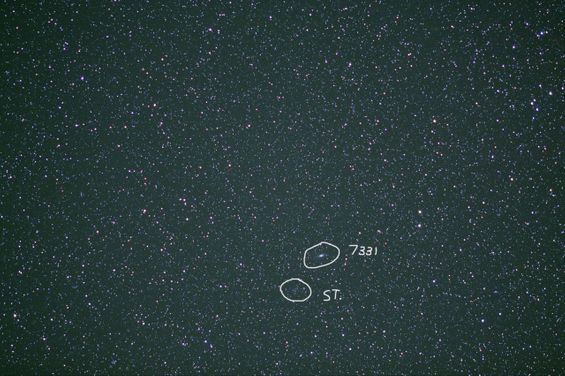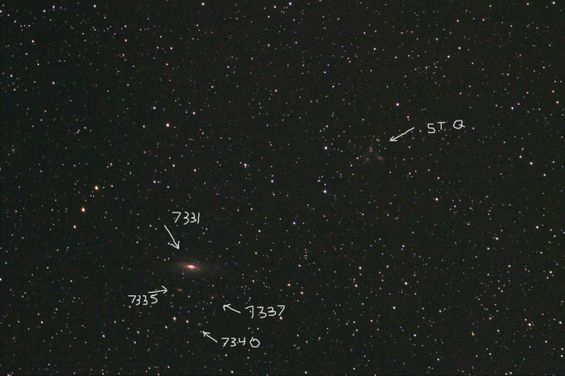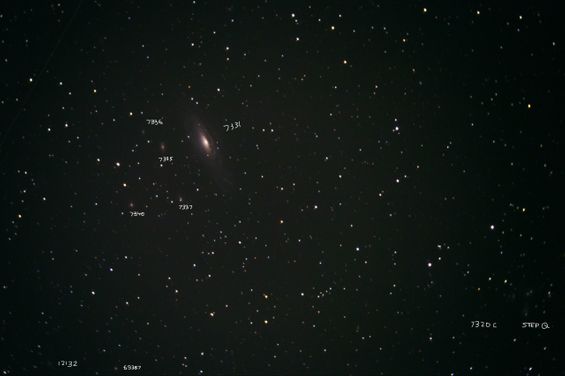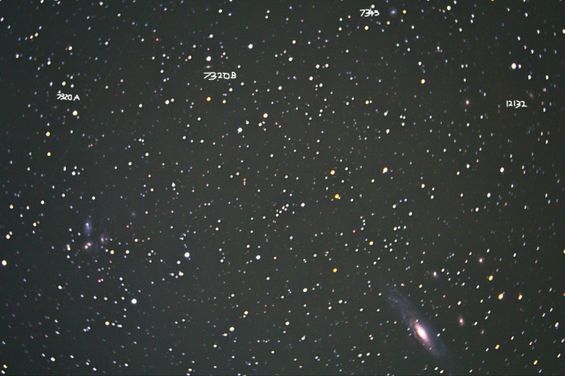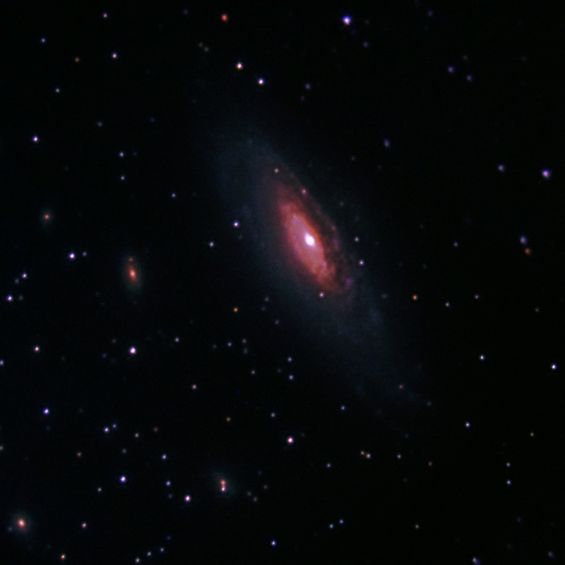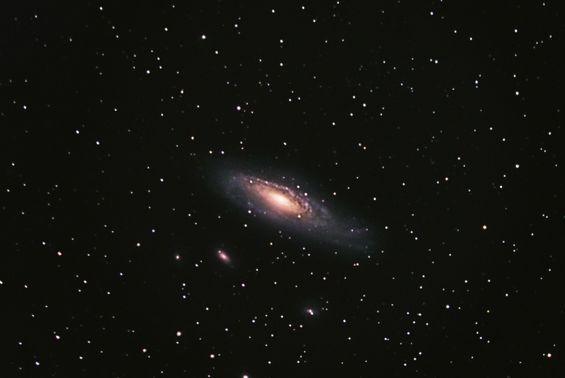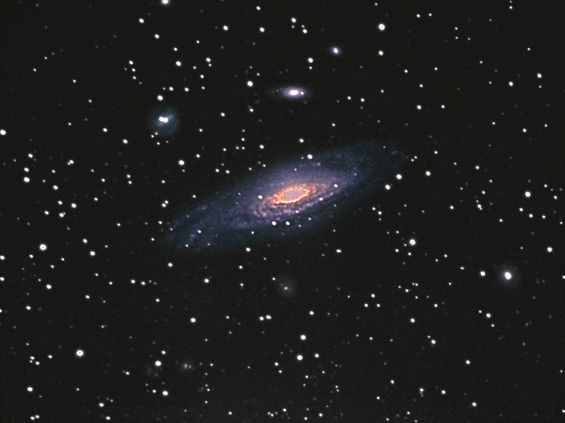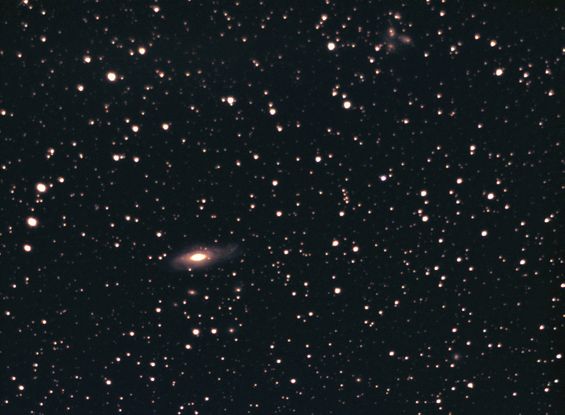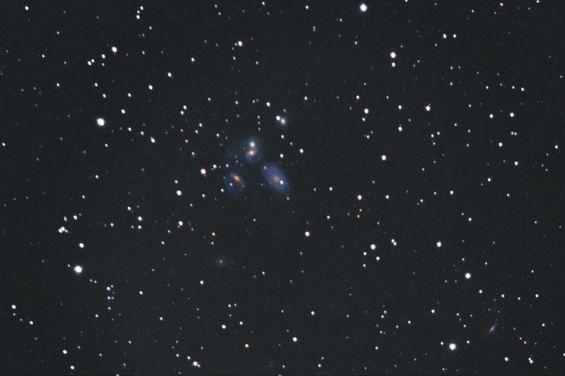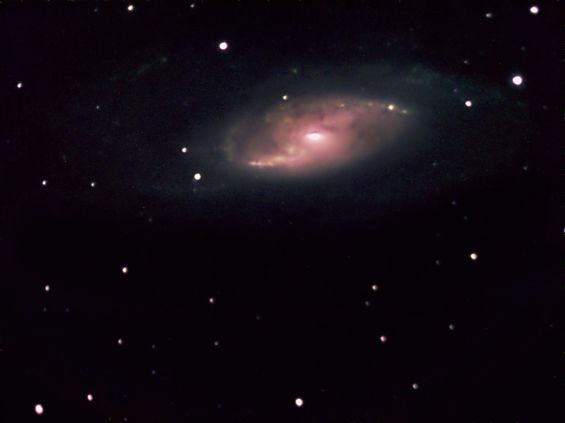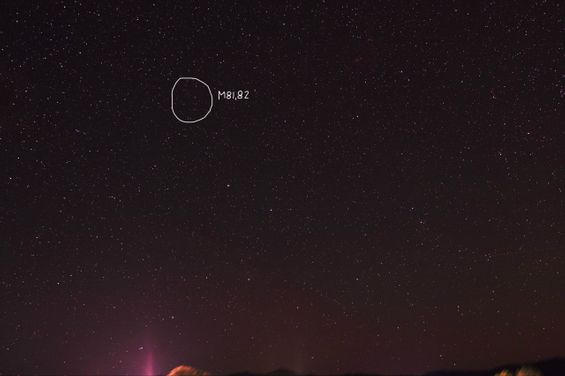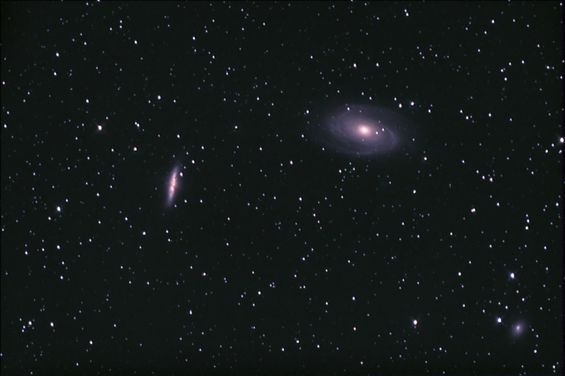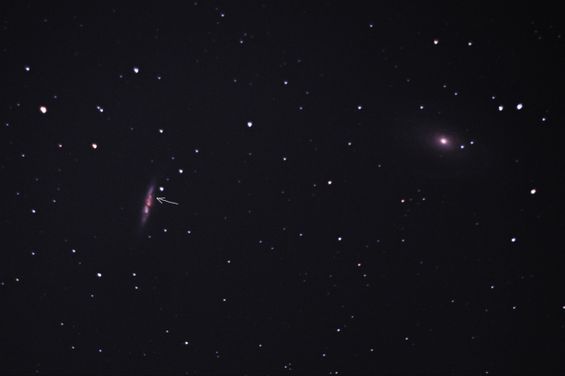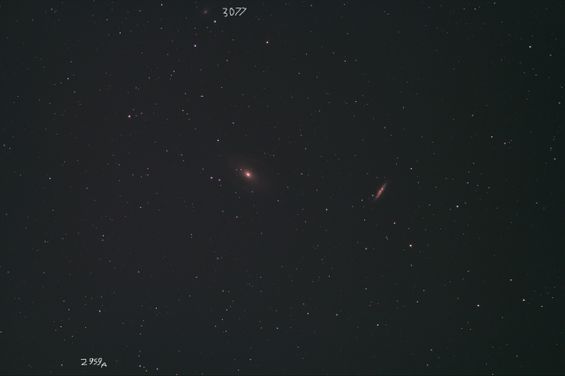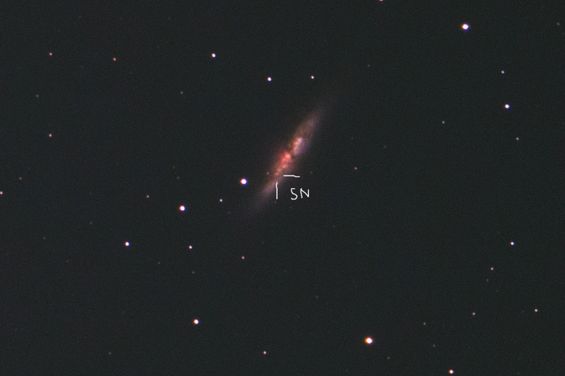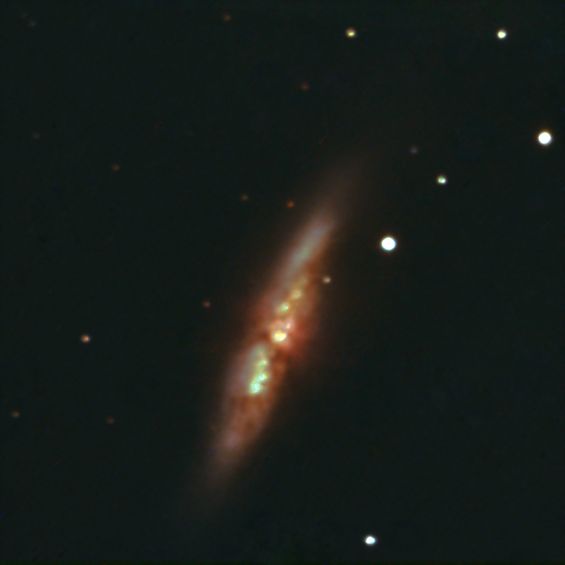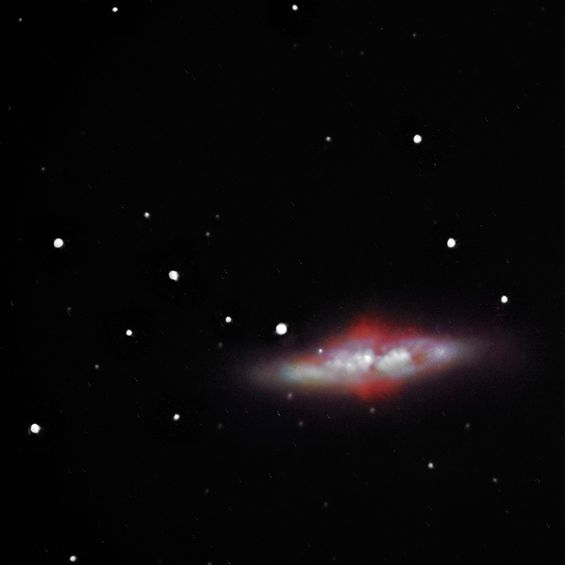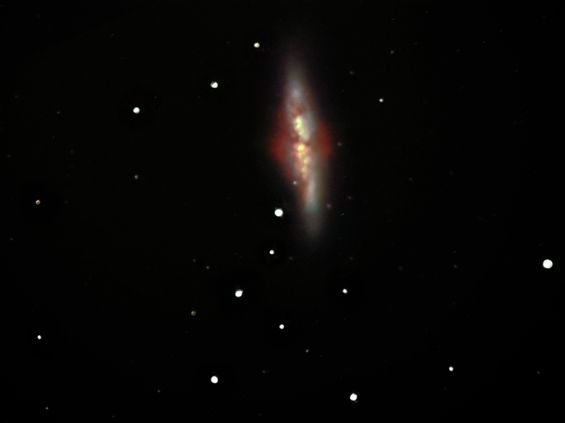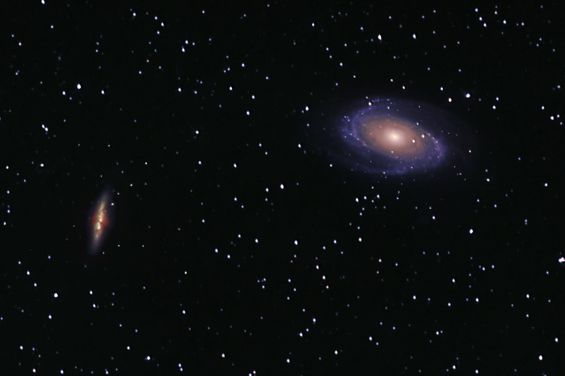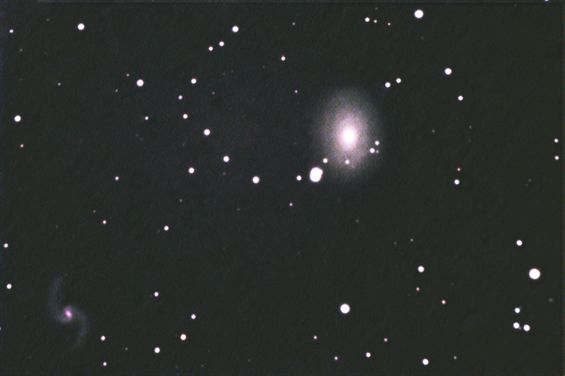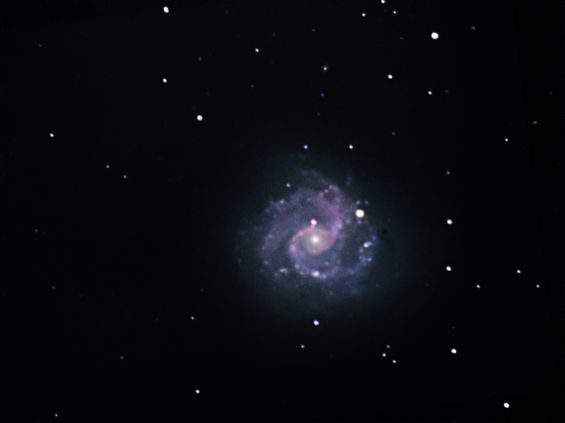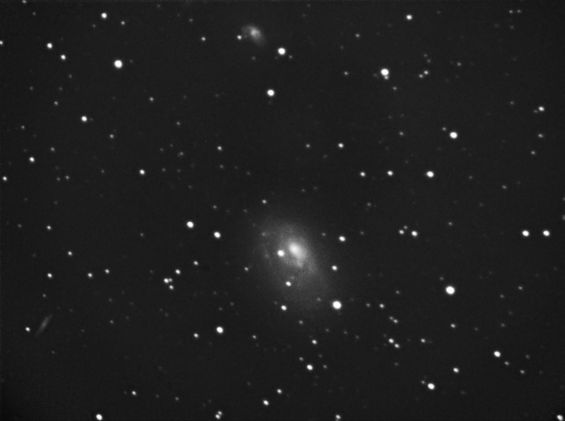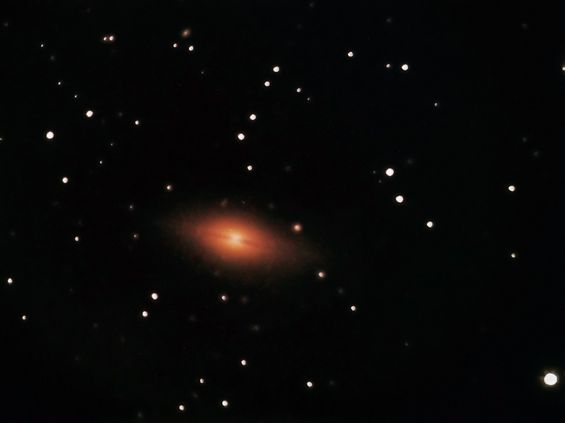Brothers and Sisters of our Milky Way
Visit also our mobile webpage
The Pinwheel Galaxy M 101 in Ursa Maior, a Hubble type SBc. We look at the galaxy from above. Its Diameter is 180,000 lightyears, i.e. more than 50% larger than our Milky Way. On the left of the photo ther is the much smaller galaxy NGC 5474(diameter 29.000LY) and above M101 the even smaller NGC 5477(diameter 10.000LY). These 2 smaller galaxies play a similar role than our own LMC ans SMC in relation to our Milky Way. All 3 galaxies are about 21million lightyears away from Earth. M101 is a large but faint galaxy which covers an area similar to the full moon but can't be seen with the naked eye. Astro photo taken on Emberger Alm, Carinthia, Austria using an 8 inch f4 Newton and Canon on EQ5 mount,
Comet Catalina passing close to galaxy M 101(distance 23 mio LY) taken on January 17th 2016. You can also see the galaxies NGC 5474(distance 21 mio LY) right of M 101 and NGC 5422(distance 101mio LY) left of M 101. Asto photo taken with Canon EOS 40d modified and Canon 2,8 200mm L Lens and teleconverter 1,4, stack of 11 exp 70 sec each 3200 ISO
Classification of galaxies
The Elliptical galaxies are usually older, red and consisting mainly of older red giant stars whereas the spiral galaxies tend to be blue with increasingly bigger shares of young blue stars from sub category a to c. The spirals are sub divided into
unbarred(S..)and barred spirals(SB..). Source internet Wikipedia.
The reason for the formation of spiral arms is not yet explained. Spiral arms are concentrations of gas where new blue stars are formed. However stars are rotating around the center of
galaxies independently of spiral arms. According to the density wave theory, spiral arms are caused by density waves.
Stars and gas clouds slow down as they pass through the denser spiral arms, gas is compressed when it enters the density wave and this
explains why we see lots of star formation in spiral arms – any giant molecular gas clouds on the verge of forming stars get that extra bit of compression as they hit the denser region and this may trigger star formation (source: http://thethoughtstash.wordpress.com/author/kashfarooq/)
Close Up of the Hubble SBc type Pinwheel Galaxy M 101 in Ursa Maior. Astro photo taken with Celestron C 14 using focal reducer at F2500mm: Canon Eos 450d mono: 1x 5' 800iso, cls:3x5' 800 iso 3x10' 800iso, 3x7' 1600 iso Color: Canon Eos 40d 2x7' 1600 iso cls only 30km outside of Vienna, Austria. Composite with the astro photo above taken with 8inch Newton.. This composite method gives you bright spiral arms due to pristine skies when using the smaller mobile scope and higher resolution of the center by using the mighty C14 from close to city skies. You can recognize the huge and bright H II hydrogen gas star creating regions in red of this type SBc barred Spiral Galaxy. Astrophoto C14.
Classification of galaxies 2
As mentioned above, elliptical galaxies mostly are red. Examples are M86 in Virgo or M32, one of the small companions of rhe Andromeda Galaxy(see astro photos below). According to recent research, the reason for these galaxies not producing a substantial
amount of young blue stars seem to be high speed jets emerging from a giant black hole in the center of the galaxies preventing gas from cooling down and forming stars(see Astronomy.com, May 2014 edition, page 24ff).
Spiral galaxies tend to be blue due
to young blue stars located mainly in the outer spiral arms. The so called green valley consists of intermediate types like red spiral galaxies or galaxies containing less young blue stars like our Milky Way and the Andromeda galaxy/
A typical blue spiral
galaxy is M51 the beautiful Whirlpool Galaxy(see Astro photos below).
Source internet Wikipedia
Whirlpool Galaxy M 51. Close up. You can see the interaction with the galaxy NGC 5195 on the right! M 51 is a beautiful example of a spiral galaxy type Sc, having spiral arms packed with young blue stars and a prominent representative of the blue cloud. Astro photo taken with Celestron C 14, with 4m focal length , 35,6cm Aperture and Orion Starshoot Pro CCd Camera, stack of ; 2x2 binning mono luminance 2x300sec+1x400sec+3x600sec 1x1 color: 5x600sec only 30 km outside of Vienna , Austria. Astrophoto C14
Whirlpool Galaxy M 51 taken with Celestron C14 using a focal reducer at F=2500mm and SBIG 2000XM monochrome CCD Camera: stack of: luminance: 6x800sec, RGB 3x300sec 2x2 binning each. The Whirlpool Galaxy is 25 million lightyears away, 70tsd LY. The Whirlpool Galaxy interacts with the galaxy NGC 5195 on the right! M 51 is a beautiful example of a spiral galaxy type Sc, having spiral arms packed with young blue stars. Astrophoto C14
Whirlpool Galaxy M 51, astro photo taken with Skywatcher Newton 8 inch and Atik Infinity CCD Camera stack of 650x5,5sec
Whirlpool Galaxy M 51. Close up. You can see the interaction with the galaxy NGC 5195 on the right! M 51 is a beautiful example of a spiral galaxy type Sc, having spiral arms packed with young blue stars and a prominent representative of the blue cloud. Astro photo taken with Celestron C 14, with 4m focal length , 35,6cm Aperture and Orion Starshoot Pro CCd Camera, stack of 14 exp 600-900sec each stacked with exposures using a focal reducer at f7 and F2500mm and Canon EOS 450d monochrome and Canon EOS 40d modified only 30 km outside of Vienna , Austria. Astrophoto C14
Whirlpool Galaxy M51 in Canes Venatici next to Ursa Maior, about 25 million lightyears away diameter about 2/3 of andromeda galaxy Astro photo taken with 8 inch newton telescope with coma corrector reducer, 73cm effective focal length and canon 30 km off Vienna , Austria
Galaxy M51 Whirlpool Galaxy taken with 80/480 APO with reducer 0,79 and Canon EOS 550d modified on Astrotrac close to Prellenkirchen Lower Austria 3x3minutes at ISO 1600
Measuring distances of galaxies
According to Hubble there is a linear relation between red shift of galaxies caused by speed and its distance from Earth. This relationship between speed and distance depends also on the value of the Hubble constant which is ranging between 65 and 78(see Astronudes blog).
v = Ho d,
where v is the galaxy's velocity (in km/sec), d is the distance to the galaxy (in megaparsecs; 1 Mpc = 1 million parsecs = 3,26 million lightyears), and Ho proportionality constant, called "The Hubble constant
see http://www.pas.rochester.edu/~afrank/A105/LectureXV/LectureXVI.html
f.ex calculation of the distance of two galaxies shown in the next two astro photos of NGC 2915 based on the radial velocity(derived from observed red shift):
galaxy PGC 27249, radial velocity 3600 km/sec: d=3600/68=53 megaparsec=173 mio LY
galaxy PGC1648681, radial velocity 10300 km/sec: d=10300/68=151 megaparsec=494 mio LY
There is another method for measuring distances using supernovae as standard candles: see also Perlmutter article in Astronudes blog, The Supernova cosmology project
Galaxy NGC 2903 in the constellation Leo.An Sb/Sc type. Distance from Earth is 30,8 million lightyears and diameter is 113.000 LY. On the left side of the photo you can recognize also the galaxy NGC 2916, distance 132 million LY, diameter 96.000 LY. The very tiny galaxy below NGC 2915 is PGC 27249(see arrow), having a radial velocity of about 3600 km/sec indicating a distance of about 170 million lightyears(calculation formula see above under measuring distances) Astro photo taken with 8 inch f4 Newton at Emberger Alm, Carinthia, Austria.
Galaxy NGC 2903 in Leo. See also the small galaxy on the bottom directly underneath NGC 2903.It is known as PGC 1648681having a radial velocity of about 10300 km/sec and a size of about 0,4x0,3 arcmin. This indicates a distance of about 500 million lightyears from Earth(see formula above under measuring distances) Astro photo taken using Meade SC 10inch, 2,5m focal lenght 30 km east of Vienna Austria and stacked with the 8inch Newton photo above. This composite method gives you bright spiral arms due to pristine skies when using the smaller mobile scope and higher resolution of the center by using the large telescope from close to city skies.
Galaxy M 99, the Coma Pinwheel Galaxy in Coma Berenices. M 99 is 50 Mio LY away and has a diameter of 79k LY, about 80% of our own galaxy the Milky Way. you can also see the galaxies PGC 169043(distance 1880 mio LY) , PGC 169040(distance 1000mio LY) and PGC 165065(distance 590mio LY) above M99. Astro photo taken with Celestron C14 using a focal reducer at F=2500mm f7 composite of 9 exp taken: luminance: 3x360sec ISO 800, 3x 720sec ISO 800 with Canon EOS 450d mono RGB: 3x360sec ISO 800 with Canon EOS 40d modified
Galaxy Group NGC 4302 and NGC 4298, interacting galaxies in Coma Berenices. The galaxies are about 55 Mio LY away. NGC 4298 is a spiral Galaxy of Hubble Typ SAc, diameter 50,000LY and NGC 4302 is a Sc type, diameter 170.000LY. The distance between the galaxies is only about 35.000LY! Astro photo taken with Celestron C14 an focal reducer at f7 F2500mm. Luminance: Canon EOS 450d monochrome: 1x200sec ISO 1600, 2x400sec ISO 800, 3x520sec ISO 800, 1x940sec ISO800 CLS filter,3x640sec ISO 1600 CLS filter RGB Canon 40d modified: 3x480sec ISO 800, 3x480sec ISO 1600 CLS filter astro photo C14
Galaxies NGC 3718(right), NGC 3729(left) and the Hickson Galaxy Group 56 of five galaxies(bottom right in the constellation Ursa Maior. Distance to NGC 3718 and NGC 3729 is about 69Mio LY, the Hickson Group is about 400Mio LY away. The twist in GX NGC 3718 is caused by interaction with nearby NGC 3729. Diameter of NGC 3718 is about 131.000LY, its a type SBa, whereas NGC 3829 is much smaller with a diameter of 54.000LY. The distance between these two galaxies is only about 150.000LY!! Astr photo taken with Celestron C14 and focal reducer at F 2500mm, f7: Luminance with Canon EOS 450d monochrome3x500sec ISO 800, 3x520Sec ISO 1600 with CLS, 3x 720sec ISO 1600 CLS RGB EOS 40d mod. 3x760sec ISO 800
Galaxies NGC 4567 and NGC 4568 the so called Siamese Twins, distance 60Mio light years. The galaxies are in the process of colliding and merging with each other. On the right side you can see also the gx NGC 4564 in about he same distance. Astro photo taken with Celestron C14: composite of 1)4exp taken using a focal reducer at F=2500mm f7: luminance 1x210sec ISO 1600, 2x 400sec ISO 1600 CLSwith Canon EOS 450d mono 4x600sec, 4x400sec, 2x200sec RGB: 1x240sec ISO 1200 with Canon EOS 40d modified 2)10 exp taken with Orion Starshoot Pro CCD at F=3910mm f11
close up of the Galaxies NGC 4567 and NGC 4568 the so called Siamese Twins. Astro photo taken with Celestron C14: 10 exp taken with Orion Starshoot Pro CCD at F=3910mm f11
Cocoon Galaxies in constellation Canes Venatici distance 50mio LY, diameter of the larger galaxy NGC 4490 is half of our Milky Way, 50.000LY, the smaller gx NGC 4485 has a diameter of 20.000LY. The two galaxies are now 25.000LY away from each other. They had ocollided in the past, whereby NGC 4490 lost its spiral structure; also the massive red star creation areas were caused by this collision. For comparison: The Large Magellanic Cloud, companion of our Milky Way, has a diameter of 15.000LY and is 6 times farer away the NGC 4485 from NGC 4490. Astro photo taken with Celestron C14 and focal reducer at F2500mm and f7. Composite of 1) Luminance Canon EOS 450d monochrome: 3x200sec ISO1600, 3x270sec ISO 1600, 3x560sec ISO 1600 CLS filter RGB: Canon 'EOS 40d modified: 3x340sec ISO1000 Halpha: Canon EOS 450d monochrome 3x320sec ISO 1600 and 2)SBIG 2000cm CCd Camera> Luminance 3x800sec RGB 3x300 sec 2x2 binning each
Galaxy NGC 3521 in Leo, 37 mio LY away, diameter 127tsd LY, hubble type Sb. astro photo taken with Celestron C14 and focal reducer at f7, F=2500mm and Canon EOS 450d monochrome. Astrophoto C14
Galaxy NGC 5033, distance 37 mio LY, diameter 204thsd LY Hubble type Sc in Canes Venatici Astro photo taken with Celestron C14 and focal reducer at F2500mm, f7 Canon EOS 450d monochrome: 3x15min 800ISO 3x15min 1600ISO CLS filter 3x15min 1600ISO OIII filter 2x9min 1600ISO Halpha filter
Galaxy NGC 5005, type SBbc 70mio LY away in Canes Venatici, contains a super massive black hole. Astro photo taken with Celestron C14 using focal reducer at f7, F2500mm and Canon EOS 450d monochrome 3 exposures between 5 minutes, 800 ISO without filter,3*7min CLS filter1600ISO for luminance, 2*15min 1600ISO OIII, 1*15min,1600ISO Halpha. Astrophoto C14
Galaxy Group around NGC 4216 in Virgo. NGC 4216 is barred spiral galaxy type SBb, 49 mio LY away in the center of the astro photo. The large galaxy on the bottom left is NGC 4206, 60 mio LY distance; on th top right corner NGC 4222, distance 73mio LY. In addition you can see several small gaqlaxies, amongst them in the bottom center IC771, about 300Mio LY away. Astro photo taken with Celestron C14 using focal reducer at f7, F2500mm and Canon EOS 450d monochrome 9 exposures between 5 and 7minutes, 800-1600 ISO wirh and without CLS filter for luminance and CDanon EOS 40d for RGB. Astrophoto C14
Galaxy M100 taken with Celestron C14 using focal reducer at f7, F2500mm and Canon EOS 450d monochrome 9 exposures 3*7minutes,1600 ISO wirh CLS filter for luminance,3*15min 1600ISO each with OIII and Halpha. M100 is a SBbc spiral galaxy 47mio LY away, on the left bottom one can see the galaxy NGC 4312 and above M100 there are 2 small galaxies NGC 4328 and NGC 4322. Astrophoto C14
Galaxy M109, one of the galaxies which have a similar structure to our Milky Way. Astr photo taken with Celestron C14 using a focal reducer at f7. Luminance:Canon EOS 450d monochrome: 3x380sec 800ISO, 3x500sec ISO 1600 CLS filter and 2x860sec ISO 1600 CLS RGB Canon 40d modified 3x400 sec ISO 800 M109 is a barred spiral galaxy type SBc about 80 million LY awaywith three satelite galaxies also to be seen on the astro photo. astrophoto c14.
Galaxy NGC 2683 in Lynx, 33 Million LY away taken with Celestron C14 and Orion Starshoot Pro Color CCD Camera. Astrophoto C14
Galaxy NGC 2403, an Sc type spiral gx, distance 8million LY. Astro photo taken at Emberger Alm during Internationales Teleskoptreffen ITT, International Telescope Meeting using Meade 10inch SC and focal reducer at F=1600mm. 4 exposures ISO 1600, 360sec each.
Galaxy NGC 5907 also known as splinter galaxy in constellation Draco, type Sc, diameter 150.000 LY, distance 54 million LY. On the bottom right side you can also see the galaxy PGC 4541551. Astro photo taken with Meade 10 inch SC at Hadres, Wine Quarter(Weinviertel), Lower Austria.
Galaxy NGC 5907 in the constellation Draco. Distance about 54 mio LY, diameter 150m LY. Astro photo taken with Celestron C14 and focal reducer at F=2500mm, f7 Luminance: Canon EOS 450d monochrome: 3x380sec ISO 800, 2x860sec ISO 1600 CLS filter RGB: Canon EOS 40d modified: 2x400 sec 800ISO
Galaxy NGC 5907 so called Splinter Galaxy in the constellation Draco. Distance about 54 mio LY, diameter 150m LY. Astro photo taken with 8 inch Sky Watcher Newton and Atik Infinity CCD Camera F 740 mm, stack of 650x5,5 sec
The Sunflower Galaxy M 63 in Canes Venatici, a type Sb/c forming part of the M51(Whirlpool Galaxy) group, 37 million lightyears away, diameter 110,000 LY. See the awesome beauty of Mother Nature!! Astro photo taken using Celestron C 14 and Orion Starshoot Pro Color CCD Camera, stack of 22 exposures: Mono 2x2 binning: 1x200sec, 6x300sec RGB 1x1 binning 1x300sec,1x400sec,3x500sec,5x600sec, 5x900sec close to the City of Vienna, Austria, Astrophoto C14
Sunflower Galaxy M63 Astro photo taken with Celestron C14 Composite of the astrphoto taken above with Orion Starshoot Pro CCD Camera and Canon EOS 450d mono using focal reducer at f7 3 exposures a 300sec 800ISO
The Sunflower Galaxy M 63 in Canes Venatici, a type Sb/c forming part of the M51(Whirlpool Galaxy) group, 30 million lightyears away, diameter 65,000 LY. The knot like filaments are star creating areas. See the awesome beauty of Mother Nature!! Astro photo taken with Celestron C 14, composite of 1)Sbig 2000 xm Mono CCD camera: luminance 1x800sec, 1x300sec RGB 3x300sec 2x2binning each 2) Astro photo above using Orion Starshoot Pro Color CCD and Canon EOS 450d mono Camera Astrophoto C14
The galaxy Centaurus A, NGC 5128, also called Hamburger Galaxy in the constellation Centaurus. Its a type S0 spiral galaxy, diameter 150.000 LY, distance 11 million LY. The galaxy is part of the M83 group. In addition you can see in the right botttom the galaxies NGC 5090 and 5091, 150 million LY away. Astro photo taken usin a 6inch f4 photo Newton on Astrotrac mount and Manfrotto carbon tripod with Canon!! stack of 7 exposures of 2-3 minutes each, 1000-3200 ISO on the island of Fuerteventura, Canary Islands, Spain.
M83 a barred spiral galaxy type SBc in Hydra, 15 mio lightyears away with a diameter of 68.000LY. This bright galaxy stands deep in the South over the horizon, even in Southern Turkey. Astro photo taken using 80/480 triplet APO on Astrotrac mount at the Lissiya resort near Fethiye on the South coast of Turkey.
M83 a barred spiral galaxy type SBc in Hydra, astro photo taken using 6inch f4 Photo Newton on Astrotrac mount and Canon on the Island of Fuerteventura, Canary Islands, Spain!! Stack of 6 exposures of 2-3 minutes each 1000-3200 ISO. You can see more details compared to the astro photo abovr taken with the much slower 80/480 APO on the same mount.
Fireworks Galaxy NGC taken with APM APO 107/700 and focal reducer 0,79 and Canon EOS 550d modified. stack of 5 exp 1024sec each at ISO 1600
The Fireworks Galaxy NGC 6946 in the constellation Cygnus and Cepheus Luminance taken with Celestron C 14 and focal reducer at f7 with Canon EOS 450d monochrome: 2 exp ISO 1600 5min and 2exp 1600 ISO 12min CLS filter. RGB taken with Meade 10inch SC at the village of Schrick, Lower Austria, about 20km North of Vienna. 10 eight minutes exposures at f10 and 1600 resp. 3200 ISO. The Fireworks Galaxy is a type SBc(see Hubbles classification scheme below), 22 Mio LY away and measures 75.000 LY in diameter, about 3/4 of our Milky Way. Its very difficult to observe as it is hidden behind intergallactic gas and dust. This is the most active star forming galaxy in our neighborhood which can be seen on the picture by the large number of red H alpha regions in the spiral arms, which had encountered 8 supernovae explosion within the last 100 years which is record
Fireworks Galaxy, composite of the two astro photos above and SBIG 200sec 3exp 2x2 binning luminance
Fireworks galaxy taken with Atik Infinity and Skywatcher 8inch f4 Newton close to Vienna 200exp 5sec each
Spindle Galaxy NGC 5866, a type SO gx in the constellation Draco, 50million lightyears away. You ca n also recognize several more galaxies: NGC 5862(400 LY away), NGC 5894(600 million LY away),NGC 5870(75 million LY away), PGC 2508806( 400 million LY away),NGC 56828(400 mio LY away), 5866A(companion of the Spindle gx, same distance). Astro photo taken with Celestron C 14 using a focal reducer f5, 8 exposures 7 minutes each at 400 and 800 ISO, 3 exp using CLS filter, 6 without filter, close to Vienna, Austria. Astrophoto C14.
Spindle Galaxy NGC 5866, taken with Celestron C 14 and focal reducer at f7. Luminance: 3x7'cls +3x12' cls 1600iso RGB 3x4' 1600iso
The Whale Galaxy NGC 4631(diameter 115.000LY) with its small companion NGC 4627 and the Crowbar Galaxy NGC 4656(diameter 90.000LY). The galaxy group is about 25 million LY away. Astro photo taken at Lissiya Resort near Fethiye, South coast of Turkey using a 80/480 triplet APO unguided on Astrotrac mount and light carbon tripod!(set up picture see section Astronuder hotels)
The Whale Galaxy NGC 4631(diameter 115.000LY) with its small companion NGC 4627 and the Crowbar Galaxy NGC 4656(diameter 90.000LY). The galaxy group is about 25 million LY away. Astrophoto taken at Emberger Alm Carinthia using Canon EOS 550d modified camera and APM APO triplet 107/700 mm on EQ 3 mount 3 exp a 8 min ISO 1600
The Whale Galaxy NGC 4631, a starburst Sc type galaxy located in Canes Venatici, 25 million lightyears away and 115.000LY diameter.You can see the blue spiral arms and the red star nurseries. Above the whale galaxy there is the small elliptical type E4 galaxy NGC 4627, the small companion. Astro photo taken with Celestron C 14 using focal reducer and canon 450d mono and canon 40d mod only 30km outside of Vienna, Austria. luminance: 3x5min, 3x7min without filter, 3x12min withh CLS all 800ISO Astrophoto C 14.
Whale Galaxy NGC 4631 and the Crowbar Galaxy NGC 4656 Astro photo taken with 80 480 Explore Scientific Triplet APO and focal reducer at f 4,8 on Skywatcher travel mount without guiding and Atik Infinity CCD camera, stack of 200exp 5,5sec each
Sombrero Galaxy M104 in Virgo; we look at this galaxy edge on. 34 million lightyears away, 84.000 lightyears diameter, about 3/4 of our own Milky Way. The halo consists mainly of 1200-2000 globular clusters, about 10 times more than our Milky Way. The most distinguishing feature of this galaxy however is the prominent dust lane. It's a Hubble type Sa galaxy. However according to more recent observations by NASAs Spitzer telescope the sombrero galaxy appears to be a giant elliptical galaxy with a thin embedded disk, like one galaxy inside the other Astro photo taken with 8 inch Newton f4 and Canon at Emberger Alm, Carinthia, Austria
Sombrero Galaxy, astro photo taken with Atik Infinity and 80/480 triplet APO using 0,79 reducer, stack of 200x6 sec at Hohe Dirn Upper Austria
Close up of Sombrero Galaxy M104 in Virgo taken with Celestron C 14 only 30 km outside Vienna, Austria; RGB: Orion Starshoot Pro CCD Camera: 2x2 binning mono: stack of 5exp a 300sec 1x1 binning color: 1exp 300sec Luminance> Sbig 2000xt 1x800sec+1x300sec Astrophoto C14.
Black Eye Galaxy M64 in Coma Berenices, distance 18 million lightyears, diameter 51.000LY. The spectacular dark band of absorbing dust in the center may be formed from a merger with another small gas rich galaxy. Hubble type Sb galaxy. Astro photo taken with Celestron C 14 and focal reducer at f7 only 30 km outside Vienna, Austria. Stack of: Canon EOS 450d mono 3x7min and 2x8min ISO 800 and EOS 40d mod 3x5min ISO 800. Astrophoto C14
The Needle Galaxy NGC 4565 in Coma Berenices.Close up. Astro photo taken with Celestron C 14, 4m focal length, 35.6cm aperture; composite of 8 exposures, total exposure time 80 minutes with 1600-3200 ISO, 30km east of Vienna, Austria. Astrophoto C14
The Needle Galaxy NGC 4565 in Coma Berenices. Diameter 200.000 lightyears(nearly twice our Milky Way!!), distance 43 mio lightyears, Hubble type Sb On the bottom you can see the galaxy NGC 4562/4565 A and on the right the galaxy NGC 4565 B Astro photoomposite of: 1. taken with Celestron C14 and focal reducer at f7: 1.1.Canon EOS 450d monochrome: 3exp 5min 800ISO and 3exp 7min 1600ISO CLS filter 1.2.Canon EOS 40d modified 3exp 5min 800ISO and 3exp 7min 1600ISO CLS filter 2.Canon EOS 401d F=3910mm astro photo above
Edge on galaxy NGC 891(silver silver galaxy) in constellation Andromeda(see also text below) Astro photo taken with Skywatcher Newton 0,6m focal length and 13cm aperture on the south coast of Crete Greece Magnified detail. There are two more faint galaxies on this photo; NGC 898, 230million lightyears away, in the top right corner and NGC 906, 200 million lightyears away, in the bottom right corner, both about the size of our Milky Way
Galaxy NGC 891 taken with Meade 10inch SC at Emberger Alm during the 30th Internatiónal Telescope Meeting ITT Internationales Teleskoptreffen.
New Travel Equipment! Astrophoto taken with Atik Infinity CCD Camera and APM APO 107/700 on Skywatcher EQ 5 mount. 50x12sec, Galaxy NGC 891
Close up view of Edge on type Sb galaxy NGC 891 called Silver Silver Galaxy, 30 million lightyears away from us, diameter about 100.000 lightyears which is a little bit less tha our own Milky Way. We look at this galaxy from the side Isn't that amazing! Astro photo taken with Celestron C 14, 4m focal length, 35.6cm aperture and Orion Star Shoot Pro Color CCD Camera 30km east of Vienna, Austria; stacked with the Astro photo above. This composite method gives you bright spiral arms due to pristine skies when using the smaller mobile scope and higher resolution of the center by using the large telescope from close to city skies. Astrophoto C14.
Galaxy NGC 891 Astrophoto taken with Celestron C14 and focal reducer at f7 SBIG 2000xm stack of 6 exposures 800 sec each
Galaxy NGC 891 stack of photo above with SBIG 2000xm mono CCD camera and Orion Starshoot Pro Color CCD camera
LMC. The Large Magellanic Cloud with the Tarantula Nebula Picture taken in Punta Islita, Nicoya Peninsula, Costa Rica. That's a small galaxy close to our own Milky Way forming part of our local system. If some extraterrestrial intelligence lived there and would look at our Milky Way, our milky at would cover one fourth of the horizon at night sky(45 degree angle times 12 degree) it would be an amazing night companion covering an area of more than 200 times the Andromeda Galaxy, the next large galaxy group from earth The LMC can be seen only from locations on the Southern Hemisphere or close to the equator LMC is about 150.000 lightyears away, diameter about 14.000 lightyears, less than 1/7of our Milky Way Astro photo taken using a Canon 85mm lens
LMC. The Large Magellanic Cloud with the Tarantula Nebula(red in the center of the Astro photo) The Tarantula Nebula belongs to the LMC. It's an emission nebula like our Milky Way's Orion, Laguna, Eta Carinae or North America nebulae. However with a diameter of 2000 lightyears, the size of this star forming H2 region is gigantic. If it was in place of the Orion Nebula(the closest star nursery, 1400 lightyears away, diameter 23 lightyears ), it would cover an area of 60 full moons and it's glow would cast shadows on the earth. stack of Astro photos taken in Tamarindo, Nicoya Peninsula, Costa Rica using a Canon 200mm L lens and Canon in Curacao with the same instrument
LMC. The Large Magellanic Cloud AstroPhoto taken on Chale Island, Kenya. LMC is a small galaxy close to our own Milky Way forming part of our local system. If some extraterrestrial intelligence lived there and would look at our Milky Way, our milky at would cover one fourth of the horizon at night sky(45 degree angle times 12 degree) it would be an amazing night companion covering an area of more than 200 times the Andromeda Galaxy, the next large galaxy group from earth LMC and SMC can be seen only from locations on the Southern Hemisphere or close to the equator Large Magellanic Cloud LMC and Small Magellanic Cloud SMC. LMC is about 150.000 lightyears away, diameter about 14.000 lightyears, less than 1/7of our Milky Way SMC has a distance of about 200thousand lightyears and a diameter of 7000LY. Astro photo taken with Canon EOS 40d modified and Canon 1 2,8 17-35mm L lens at F 33mm, f 3.2 ISO 800 stack of 5exp
Leo Triplet, a galaxy cluster consisting of M65, M66 and NGC 3628, all about 35-40 Mio lightyears away and 90,000 to 170.000 lightyears diameter, whereby NGC 3628 on top of the photo is the largest. M 65 is on the right. In addition one can see on the bottom right the small galaxy NGC 3593(only 18 mio lightyears away, only 27.000 lightyearsv diameter, i.e. twice the LMC) Astro photo taken with Canon 200mm L tele lens in Alentejo, Portugal; magnified detail
Leo Triplet, a galaxy cluster consisting of M65, M66 and NGC 3628, all about 35-40 Mio lightyears away and 90,000 to 170.000 lightyears diameter, whereby NGC 3628 on top of the photo is the largest. M 65 is on the right. In addition one can see on the bottom right the small galaxy NGC 3593(only 18 mio lightyears away, only 27.000 lightyearsv diameter, i.e. twice the LMC) Astro photo taken with 80/480 APO Triplet explore scientific using a 0,79 reducer and Canon EOS 40d modified on Astrotrac mount , stack of 8exp a 80sec ISO 1600
Leo Triplet , a galaxy cluster consisting of M65, M66 and NGC 3628, all about 35-40 Mio lightyears away and 90,000 to 170.000 lightyears diameter, Astro photo taken with 80 480 Explore Scientific Triplet APO and focal reducer at f 4,8 on Skywatcher travel mount without guiding and Atik Infinity CCD camera, stack of 200exp 5,5sec each
Leo Triplet, a galaxy cluster consisting of M65, M66 and NGC 3628, all about 35-40 Mio lightyears away and 90,000 to 170.000 lightyears diameter. In the bottom left you can recognize a very small galaxy, IC 2745 estimated distance 145 mega parsec, i.e. about 500 million lightyears. Astro photo taken with 8 inch f4 Newton at Emberger Alm, Carinthia, Austria.
Location of the Andromeda Galaxy M31 and the Triangle Galaxy M33 next to the Milky Way`s Perseus spiral arm and the characteristic W of Cassiopeia. Above Cassiopeia you ca see the famous open clusters h and chi Persei and the red heart of Valentine Nebula Astro photo taken with Sigma 1:1,8 20mm in Death Valley, California
Andromeda Galaxy M 31 taken with Canon 24-105 L lens at f4, F105mm, 5min exp. with ISO 800 piggy packed on Celestron C 8 on Nexstar SE 1 mount. astro photo taken at Hadres, Wine Quarter(Weinviertel), Lower Austria. This seems to be the astrophotographical limit for this mount, however when using the Nexstar SE 1 which I successsfully tested visually up to 8 inch SC its a nice feature to be able to take also pics up to about F=100mm. In our opinion, the Astrotrac mount is however much more suitable for mobile astro photography up to a 6inch Newton, whereas the Nexstar is much better visually.
The Andromeda Galaxy M 31, it's the closest large galaxy, about 120.000 lightyears in diameter and 2 Mio lightyears away from us. Its belongs to the so called green valley and a type Sa/b. It's about the same size as our own galaxy, the Milky Way, and is also accompanied by two major small galaxies, M 32(left close to the outer spiral) and M 110, in a little distance to the right. These to major satellite galaxies are also approximately the same size as the two major satellite galaxies of our Milky Way, the large Magellaicn cloud LMC(diameter 14.000 lightyears) and the small Magellanic cloud SMC( diameter 7000l lightyears). Astro photo taken using a Canon 200mm L lens and 1,4 converter on Astrotrac mount in Borego State Park South East California
Andromeda Galaxy Astro photo taken with Skywatcher Newton 0,6m focal length and 13cm aperture on the south coast of Crete
Andromeda Galaxy M 31 teken with 80/480 Triplet APO at Hadres, wine quarter(Weinviertel), Lower Austria.
Andromeda Galaxy M 31 and the smaller companion M32(bottom right) taken with Celestron C14 and 0,63 reducer, F=2500mm, close to Vienna. Stack of 6 exposures at 800 ISO 180 sec each.
Galaxies M31 and M110. Astro photo taken with Celestron C14. Astrophoto C14
Andromeda Galaxy M31, compsite of the APO and C14 astro photos above, the photo taken in Death Valley using a Canon 2,8 200mm Llens and two more C14 exposures
Galaxy M 31 Andromeda Galaxy Luminance: Astro photo taken with 80/480 APO Triplet and EOS 450d monochrome 2 exposures a 9 minutes with 800 ISO at Emberger Alm, Carinthia Austria nduring the ITT International Telescope Treffen RGB Astrophoto taken above
Andromeda Galaxy M31 taken with 107 700 APM triplet APO and Canon EOS 550d modified at Gerlitzen, Hotel Pacheiner 5 exp 8 min ISO 1600
Close up of the Andromeda Galaxy Astro photo taken with a Celestron C 14, 4m focal length , 35,6cm Aperture, 30km east of Vienna, Austria Astrophoto C14
Galaxy M 32, the smaller of the two major companions of the Andromeda Galaxy, with a diameter of 6000 lightyears, about the same size as the Small Magellan Cloud, the smaller companion of our own Milky Way. In the right bottom corner you can see a glance of the outer arms of the andromeda Galaxy. M32 is an elliptical galaxy type E2. Astro photo taken with Celestron C 14, 4m focal length , 35,6cm Aperture and canon Astrophoto C14
Triangle Galaxy M33, the relative second largest galaxy except the Magellan clouds to be seen from Earth, it's absolute diameter is about half the size of Andromeda Galaxy, 60.000 lightyears and about 50% farer away, 3 million lightyears. It's a Hubble type Sc spiral galaxy, part of the blue cloud full if young blue stars. Astro photo taken using a Canon 200mm L lens and 1,4 converter Borego State Park South East California
Central region of the Triangle Galaxy M33 with the mighty HII regions to be clearly seen. the largest HII region on top right is NGC 604 and the second largest in the center bottom is NGC 595. NGC 604 has a diameter of 1500LY. To compare: Lagoon nebula has a diameter of 60LY, Eta Carinae Nebula 300LY, Orion Nebula 23LY, North America Nebula 65LY. Only the Tarantula Nebula in the LMC is with a diameter of 2000LY larger. Composite Astro photo 1) taken with Celestron C14 and focal reducer at F=2500mm; Luminance: Canon EOS 450d mono stack of 6 exp, using a CLS filter ISO 1600, 9min each RGB: Canon EOS 550d modified ISO 1600, 5exp 5 min each 2)Astro photo below taken with APM APO 107/700 and Canon EOS 550d mod at Embergaer Alm Carinthia to get the spiral arms 3)Astrophoto taken with Celestron C14, reducer at F 2500mm and SBIG 2000xm mono CCD camera: lum:7x800 sec 1x1 binning RGB: 300sec 2x2binning each Astrophoto C14
Triangle galaxy M33 Astro photo taken with APM APO 107/700 and Canon EOS 550d mod at Embergaer Alm Carinthia. Stack of 7 exp a 500sec ISO 1600
Silver Dollar Galaxy and globular cluster NGC 288 in constellation Sculptor. The Galaxy is about 1/3 smaller than our own Milky Way or the Andromeda Galaxy and with more than 10Mio lightyears distande from Earth and 5 times farer away than the Andromeda Galaxy(compare pic above). Silverdollar is a star burst type galatxy, a fast star creator of Hubble type Sc, part of the blue cloud. Astro photo taken using a Canon 200mm L lens at Nicoya peninsula Costa Rica
Sculptor Galaxy or Silver Dollar Galaxy, an Sc type star burst galaxy. You can easily recognize the active star creation areas. astr photo taken with 10inch Meade SC at Emberger Alm during the 30th International Telescope Meeting ITT Internationales Teleskoptreffen. Stack of 5 exp at ISO 1600, 180 to 240 sec each.
Fornax Galaxy cluster 62 million light years away, thats 30 times further away than the Andromeda galaxy! The most famous galaxy is the S shaped NGC1365 about 1 1/2 times the size of our Milky Way (on the uleft) There are many other galaxies to be seen on this astro photo taken using a Canon 200mm L lens at Nicoya peninsula, Costa Rica(see negative of this pic below)
negative of the above astro photo of the Fornax Galaxy cluster
Galaxy NGC 1365, magnified detail of the Astro photo above. A wonderful example of a barred spiral galaxy type SBb.
Virgo galaxy cluster, about 54 million lightyears away; astro photo taken with Canon 200mm L tele lens in Alentejo, Portugal; description see below
negative of the astro photo abova of the Virgo galaxy cluster. The blue rectangular is shown in the next astro photo. M99 has a beautiful spiral structure even to be seen on the 200mm Tele Lens photo! The orange rectangular APO is shown in the second photo below.
Virgo galaxy cluster, close up using 8inch f4 Newton and Canon at Emberger Alm, Carinthia, Austria: You can see in the left top center the famous Markarjan eyes NGC 4438(diameter 135.000 LY) and 4435(diameter 43.000 LY). The two bright elliptical galaxies type E1 and E3 on the right top center are M86 and M84. Other bright galaxies to be recognized: NGC 4425, 4407, 4388 and 4402. On the center bottom you can see 3 small galaxies with a diameter of about 25 thousand LY. All galaxies are about 50-60 million lightyears away.
The Eyes Galaxies in the Markarian Chain in the Virgo Cluster, distance 52Mio LY, the galaxies are only about 100.000LYapart and interacting. They seem to have approached to as close as 16000LY in the past. Gravitational tides from this close encounter has ripped away stars and dust. Astro photo of the Eyes taken with Celestron C14 and focal reducer at F2500 f7 Luminance EOS 450d monochrome 3x300sec,3x420sec,3x540sec ISO 800 RGB EOS 40d 3x300sec ISO 800 in addition stacked with the astro photo above taken with 8inch Newton at Emberger Alm in order to enhance the dust between the galaxies
Virgo Cluster taken with 80/480 triplet APO on Astrotrac mount at Lissiya resort, Southern Turkey coast. On the top you can see the Marcarjan chain and on the bottom the giant galaxy M87, the strongest X-Ray source in the Virgo cluster.
Galaxies M95(center) and M96(top) in Leo. Both galaxies are about 35million lightyears away and measure about 75.000lightyears in diameter, which is 2/3 of our Milky Way. M95 had a supernova in March 2012 when the Astro photo was taken The supernova is the dot close to the bottom left of the center of the galaxy. Astro photo taken using Zeiss 300mm tele lens with Canon at Emberger Alm, Carinthia. You can see the supernova even using shorter focal lenght!! See also section Supernovae!
Galaxies M95 with supernova(SN) and M96. magnified detail of the astro photo above taken with 300mm Zeiss tele lens as a negative
Galaxies M96(left) and M95 without supernova taken in March 2014 at Emberger Alm, Carinthia, Austria using 8inch f4 Newton. They are both barred spiral galaxies of type SBb respectively SBa/b.
Galaxy M 95 with supernova in April 2012. The supernova although being 35 million lightyears away in the galaxy M95, is shining as bright as many stars on this photo which all belong to our Milky Way and are only several thousand lightyears away!! Astro photo taken with 10inch Schmidt Newton close to Vienna, Austria
Galaxies NGC 7331 and Stephans Quintett(ST.) in constellation Pegasus Astro photo taken using a Canon 200mm L lens and 1,4 converter Borego State Park South East California
Galaxiy NGC 7331( 46 mio light years away, 140.000 lightyears diameter), Stephens Quintett, a cluster of 5 galaxies 300 mio lightyears away and gx 7335,7337,7340 in Pegasus. Magnified detail of an Astro photo taken with APO 80/480 Triplett and Canon at Hadres, Wine Quarter(Weinviertel), Lower Austria.
Galaxies around NGC 7331 and Stephans Quintett: NGC 7335,7336,7337,7340,7320C; PGC 69387; UGC 12132 most of these smaller gx are in a distance of about 300 million LY whereas NGC 7331 is about 46 million LY away. Astro photo taken with Meade 10 inch SC at Hadres, Wine Quarter(Weinviertel), Lower Austria.
Galaxies NGC 7331 and Stephans Qintet; in addition you can recognize many more galaxies, amongst them NGC 7320A and B(310 mio LY distance), NGC 7343(360 mio LY distance) and UGC 12132(300 mio LY distance). Astro photo taken with 10inch Meade SC at Emberger Alm during the 30th International telescope meeting ITT Internationales Teleskoptreffen).
Galaxy NGC 7331, type Sb, (46 mio light years away, 140.000 lightyears diameter; 1/4 bigger than our Milky Way). Astro photo made up of exposures taken with Celestron C14 and Meade 10inch SC. The biggest of the small gx left of NGC 7331 is NGC 7335(100.000 lightyears diameter, 300mio LY distance), Left above NGC 7335 is GSC 2743-2401(distance 420 mio LY), below NGC 7331 you see NGC 7337((distance 310 mio LY) and left of NGC 7337 there is NGC 7340(70.000 lightyears diameter, distance 305 mio LY)).
Galaxy NGC 7331 taken with Celestron C 14 and focal reducer at F 2500mm Luminance Canon EOS 450d monochrome 5x 12 min with CLS RGB Astro photo above
Galaxy NGC 7331 Astro photo taken with Celestron C14: luminance 3x 600 sec 2x2 binning Orion Starshoot Pro RGB 1x600 sec 1x1 binning Orion Starshoot Pro and Astro photo above taken with reducer
Galaxy NGC 7331 group Astrophoto taken with Celestron C14 and focal reducer at F 2500mm using SBIG 2000XM mono CCD camera Luminance 9x800 sec 1x1binning
GaGalaxy NGC 7331 group Astrophoto taken with Celestron C14 and focal reducer at F 2500mm using SBIG 2000XM mono CCD camera Luminance 9x800 sec 1x1binninglaxy Group RGB 3x300sec 2x2 binning each composite with astrophoto taken with Orion Starshoot Pro Color CCD camera(see above)
Galaxies NGC 7331 and Stephans Quintett a group of 5 gx; Astro photo taken with APM APO 107/700 and focal reducer at Emberger Alm EOS 550d, 6 exp ISO 1600, 550sec each
Astrophoto taken with Atik Infinity CCD Camera and Celestron Comet Catcher on Skywatcher Alt Az Mini mount on Hohe Dirn, Upper Austria 50x15sec, NGC 7331 group and Stephans Quintett
Stepahns Quintett Composite of: Celestron C14 and focal reducer at F 2500mm 1)Celestron C14 and focal reducer at F 2500mm Luminance EOS 450d mono at ISO 1600. 2x5min, 2x9min CLS, 3x13min CLS, 2)Celestron C14 and focal reducer at F 2500mm RGB EOS 40d modified 3x9min ISO 1600 CLS 3)celestron c14 at full focal length and Orion starshoot pro color ccd camera: 4x600 sec 2x2 mono and 3x600sec color and 2x800sec color 4)Celestron C14 and focal reducer at F 2500mm Canon EOS 550d mod. 6x732sec ISO 1600 CLS 5)APM APO 107/700 with 0,79 reducer 6x550sec Emberger Alm
Close Up of Galaxy M 106 in Canes Venatici, 25 million lightyears away, diameter 133.000 LYs, a barred spiral galaxy type SBa/b. Astro photo taken with Celestron C 14, focal reducer,2,5m focal length, 35.6cm aperture, 30 km outside Vienna, Austria. 2000XM mono CCD camera Luminance 3x800 sec 1x1binning RGB 3x300sec 2x2 binning each Astrophoto C14
Location of the Galaxies M81 and M82 in Ursa Maior not far from the Polar Star. Astro photo taken with Sigma 1:1,8 20mm in Death Valley, California
Galaxies M82(cigar galaxy-left, (details see next photo) and M81(Bodes galaxy-right) in Ursa Maior There are two more galaxies to be seen on the right side of the astrophoto, NGC 3077(bottom) and NGC 2976(top) which are both about the same size(18-20 thousand LY diameter). All 4 galaxies are approximately the same distance from earth( 12 Mio lightyears +/- 1 LY). Astro photo taken using a Canon 200mm L lens and 1,4 converter Borego State Park South East California
galaxies M81(right) and M82(left) and NGC 3077(right corner). M81 has a diameter of 95.000 lightyears(a bit smaller than our Milky Way) and is 12 Mio lightyears away, M82 has a diameter of 41.000ly and is 12,9 Mio lightyears away. NGC 3077 has a diameter of 18.000 lightyears( a little bit larger than the Large Magellan Cloud) and is 11,5Mio ly away. Astro photo taken with 8 inch Newton at the observatory Hoehenberg in Waldviertel Lower Austria on March 20th 2014 under very windy conditions. You can still see the supernova in M82 The yellow shining supernova(SN) is much fainter than in the astro photo taken one month earlier with the C 14(see below)
Galaxies M81 and M82. The supernova can still be seen on this astro photo taken on May 8th 2014 close to Vienna using a Celestron Comet Catcher on Astrotrac mount and Canon.I am really surprised about the quality of this photo taken without autoguider with this light travel mount and this extra fast scope!
Galaxies M 81, M 82,NGC 3077 and NGC 2959 and 2959A(about 220 mio LY away) taken with 80/480 Triplet APO at Schrick, Wine Quarter(Weinviertel), Lower Austria at July 25th 2014. You can still see the Supernova in M82 (see next pic).
Supernova in M 82 taken on July 25th with 80/480 triplet APO, magnified detail.
Cigar Galaxy M 82 with Supernova on Feb 20th,2014. which could also be observed very good visually! Astro photo taken with Celestron C 14, 4m focal length , 35,6cm Aperture and canon. Astrophoto C14
Cigar Galaxy M 82, about 13 million lightyears away, diameter about 40.000 lightyears which is only 1/3 of Andromeda galaxy. The center shows way more details than M 81 below. M 82 is a starburst galaxy of irregular type. Astro photo taken with Celestron C 14, 4m focal length , 35,6cm Aperture and canon Astrophoto C14
Galaxy M 81, Bodes Galaxy, composite of the two astro photos taken wit C14 above and below
Cigar Galaxy M 82, about 13 million lightyears away, diameter about 40.000 lightyears , a starburst galaxy of irregular type. Astro photo taken with Celestron C 14, 4m focal length , 35,6cm Aperture and Orion starshoot pro V2 color CCD camera. stack of 7 exposures of 800sec each and 2 exp 300 sec 2x2 mono Astrophoto C14
Galaxy M 82 Cigar Galaxy M82 is a so called starburst galaxy with high star creating activity. M82's unique bipolar outflow (or 'superwind')which you can see red in the photo is fueled by energy released by supernovae which occur at a rate of about one every ten years Astrophoto taken with Celestron C14 using a focal reducer at f7 with SBIG 200xm molnochrome CCD Camera: luminance 7x600 sec 1x1 binning R,G,B 3x300 sec 2x2 binning each Halpha 2x1000sec 2x2 binning you can see the powerful Halpha regions in the center
Galaxy M82 taken with Celestron C14 using a focal reducer at f7 and F2500mm, camera Canon EOS 450d monochrome, 3*5min Lum 800ISO, 3*8min OIII filter 1600ISO and 3*11min Halpha filter 1600ISO
Galaxy M 82, the cigar galaxy Composite of the two astrophotos above taken with Celestron C 14 and sbig 2000xm mono CCD camera at F 2500mm and ORION starshoot pro color CCD camera at F 3910 mm
Galaxy M 81 Bodes Galaxy, a spiral galaxy Hubble type Sb with blue spiral arms astrophoto taken with Celestron C14 and focal reducer at F 2500mm and SBIG 2000xm mono CCD camera luminance 6x600sec 1x1 binning RGB 3x300sec 2x2 binning each
mosaique of the 2 photos above of M81 and M82 respectively taken with C 14 and SBIG 2000xm and the astrophoto of M81 and M82 before taken with 8inch Newton
NGC 691 mag 11,39 and IC 167 mag 13,10(left). two galaxies in Aries. Astro photo taken with Celestron C14 and Orion Starshoot Pro Color CCD Camera: 1x1 binning mono: 3x600sec and 2x800sec 1x1 binning color: 3x800sec and 1x900 sec
Galaxy NGC 3184 in Ursa Major. , distance 25mio LY, Hubble type SAb, diameter 50tsd LY. Astrophoto taken with Celestron C14, focal reducer at F 2500mm and SBIG 2000xm mono CCD camera luminance: 2x800sec 1x1binning and 6x300sec 2x2binning RGB: 3x300sec 2x2binning each
Galaxy Group NGC 1961, PGC 17659(top) and PGC 17642(left). They are all in the same distance from Earth(170 mio LY). Astrophoto taken with Celestron C14 using a focal reducer at f7, and SBIG 2000xm Mono CCD camera: luminance: stack of 5x400sec 2x2binning and 4x900sec 1x1binning
Galaxy NGC 7814 in the constellation Pegasus. distance 48mio LY, diameter 80.000LY, called the small Sombrero galaxy hubble typ Sab, edge on galaxy in the top you can see the galaxy PGC 259, distance 310mio LY astrophoto taken with Celestron C14 using a focal reducer at F 2700mm and SBIG 2000XM monochrome CCD camera: luminance: 3x600 sec 1x1 and 3x300sec 2x2 binning RGB: 3x200 sec each
George 16.01.2014 16:13
The photo of Whirlpool Gaslaxy encourages me to try close ups too.
I always read about 8 to 10 hours exposure time. good to see a good pic taken in only 30 min.
Chris 05.01.2014 14:42
great celestron C 14 pics
I ve got one two
Neueste Kommentare
22.01 | 09:48
Hi Sani, great that you like it . kind regards Peter
22.01 | 09:34
Thank you for the wonderful and educative information and pictures
18.03 | 19:46
Now I understand Thanks
25.06 | 18:02
I like your mobile website too Hans

